Yale History Blog
My research into the tenure of each Yale president -- there have been eighteen -- will look for policy decision and actions taken that affected the academic life on campus during their time. I search for decisions made as each president addressed their mission to educate the best intellects for service to church and civil state. Yale, like other elite educational institutions, must evolve to remain relevant and thus fulfill its mission for each generation. As mankind evolves, so must and so has Yale.
J. Willard Gibbs - Yale and Sheffield Scientific's Contributor to Theoretical Physics
Published July 14, 2014
Born on 1839, Willard was the fourth child of professor Joshua Willard Gibbs, a professor of linguistics and theology at Yale College. The Gibbs family produced distinguished theologians and academics for many generations. On his mother's side was Jonathan Dickinson, first president of Princeton, and on his father's side, Samuel Willard, who was acting president of Harvard in 1701 - the year Yale was founded. The Gibbs family of New Haven lived for many years on High Street near the center of the Yale campus.
Willard's father, known as Joshua, was instrumental in obtaining testimony from the Mendes survivors of a mutiny which had taken over the Spanish slave ship La Amistad in 1839. The ship was captured in the ocean off Long Island and the mutineers were put on trial in New Haven in 1841 to determine their legal status.
Because the Mendes spoke only their native African language, it was impossible for them to defend themselves. Gibbs, using his linguist skills, went to New York harbor hoping to find Mendes speakers among the visiting sailors. Finding two Mendes, he brought them to New Haven introducing them to the elated imprisoned captives. Gibbs learned enough of the Mendes' language to communicate with the prisoners and assist the attorneys tasked with their defense. Testimony from the 53 Mendes captives about their capture and voyage aboard the slave ship provided the judge and jury with the reality of their plight during the New Haven trial.
The senior Gibbs was an ardent abolitionist, and his aid to the Mendes survivors was critical to the defense in the New Haven case: United States vs. The Amistad which was appealed to the Supreme Court in Washington. The case was intensely followed in a divided country deeply concerned with the political reality of human slavery.
John Adams, former president, now elderly and well respected, eloquently defended the would-be slaves before the nation's highest court. He successfully won their freedom. Thus, with Joshua Gibbs help, 35 Mendes survivors returned to their homeland using funds provided by the United Missionary Society. A few of the Mendes chose to remain in the country as free people.
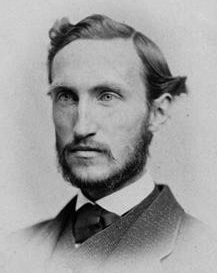 Joshua Willard Gibbs' son, known as Willard, graduated from the Hopkins school and entered Yale at 15 with the class of 1858. He was near the top of his class and, at his commencement, gave the salutatory address in Latin. After graduation, he stayed at Yale in the Sheffield Scientific School working to earn one of the first PhD degrees authorized by the Yale Corporation. Yale and the Sheffield Scientific School were the first American college to grant this advanced high academic degree. The Yale PhD degree was patterned after the technical schools of higher learning in France and Germany. No longer would students need to go to Europe to earn their PhD.
Joshua Willard Gibbs' son, known as Willard, graduated from the Hopkins school and entered Yale at 15 with the class of 1858. He was near the top of his class and, at his commencement, gave the salutatory address in Latin. After graduation, he stayed at Yale in the Sheffield Scientific School working to earn one of the first PhD degrees authorized by the Yale Corporation. Yale and the Sheffield Scientific School were the first American college to grant this advanced high academic degree. The Yale PhD degree was patterned after the technical schools of higher learning in France and Germany. No longer would students need to go to Europe to earn their PhD.
Willard's father had long been a member of the Connecticut Society of Arts and Sciences. Soon after he received his first Yale degree, Willard was inducted into this society which would prove most helpful in his later work in mathematics and physical science theory. In 1863, after years of study under Hubert Newton, he earned the fourth American PhD granted by Yale. His thesis was titled, "On the Forms of the Teeth and Wheels in Spur Gearing."
Remaining at Yale, he taught classes in Latin and Natural Philosophy in the Sheffield Scientific School.
When Josiah Gibbs died in March 1961, Willard and his sisters sat through a troubling funeral service in the College Chapel. Dr. Fisher, who gave the funeral oration, pointed out a fundamental of the senior Gibbs life: "Mr. Gibbs loved system... His essays on special topics are marked by the nicest logical arrangement. He would have done a greater service to the cause of learning. (if he had) the wider grasp, the power of more extended combination .... Through which multiform fragments of truth are organized and fused into a consistent whole."
To Willard, now the head of the Gibbs family and its rich tradition of service, these words were a ringing challenge. He was now destined to find answers to nature's most complex problems of heat and energy. His inheritance included substantial funds accumulated by his father's frugality and investment skills which allowed his son to travel extensively in Europe to learn from the top scientists of his time. Willard remained close to his sisters for the rest of his life, never marrying, but always receiving support and encouragement from the family group.
Gibbs inventive turn of mind was challenged by a braking problem faced by the rapid expansion of railroads. Mechanical brakes were affixed to each railroad car. As a train approached a station, brakemen ran through the cars applying brakes one at a time. Accidents often occurred when trains overshot the depot. Gibbs addressed this problem by inventing an air brake system which could activate all railroad car brakes at the same time. While he immediately applied for a patent it took many years for the patent to be issued whereupon the Westinghouse Company went into the manufacture of the Gibbs air-brake system which greatly improved railroad safety.
After receiving his doctorate, Gibbs was appointed tutor for three years, then, in 1867, he spent three years in Europe traveling with his sisters and meeting leading scientists, mathematicians, and physicists. He first attended advanced classes in mathematics at the Sorbonne in Paris, then went to Berlin University to study under other gifted mathematicians and scientists. He filled two notes books with the latest European opinions in many scientific subjects. He spent much time in Heidelberg attending lectures of Kirchhoff, Helmholtz, and Bunsen where he basked in the fascinating culture of new scientific inquiry.
In 1871, he returned to the Sheffield School as Professor of Mathematical Physics. Although he was a gifted lecturer who never used notes, his work was well above the average student's ability to understand his reasoning. Students were not the only intellects who had trouble following Gibbs writings filled with complex mathematical analyses and theories. Yet, he was a true gentle man, almost never critical or unhinged. His students recognized his mild demeanor understanding just enough to be impressed by a rigorous, organized, genius with a dedicated focus on understanding nature's complex world.
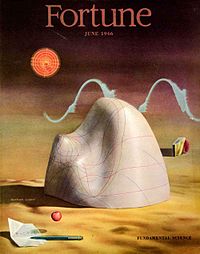 The work of a theoretical physicist is founded in a creative mind with a complete knowledge of mathematics who seeks to understand and explain the fundamentals of natural law. Thus, Willard Gibbs labored alone quietly writing his pages and making his convincing arguments often synthesized in simple equations. Correspondents included Clerk Maxwell at Cambridge, a leading scientist who understood the importance of Gibb's theories. Maxwell included a chapter of Gibbs' work in his 1875 publication "Theory of Heat."
The work of a theoretical physicist is founded in a creative mind with a complete knowledge of mathematics who seeks to understand and explain the fundamentals of natural law. Thus, Willard Gibbs labored alone quietly writing his pages and making his convincing arguments often synthesized in simple equations. Correspondents included Clerk Maxwell at Cambridge, a leading scientist who understood the importance of Gibb's theories. Maxwell included a chapter of Gibbs' work in his 1875 publication "Theory of Heat."
Gibbs finally determined to publish his basic work in thermodynamics and it was the Connecticut Academy of Arts and Sciences who undertook publication. Lacking funds, the trustees took up a collection to print Gibb's "On the Equilibrium of Heterogeneous Substances." Part 1 was published in 1875 and Part 2 in 1878. In this publication, Gibbs stated the first and second laws of thermodynamics: The energy of the world is constant. The entropy of the world tends towards a maximum.
Muriel Rukeyser, Gibb's biographer, describes him as "one of those rare intellects which tower over art, over many kinds of conquest, as over science, from whom the human race receives its pictures of the world."
These principles launched the field of physical chemistry. After Gibb's "Great Paper" was translated into German and published abroad, German scientists became the founders of a great chemical industry that produced many useful products that benefited mankind.
In 1879, Gibbs spreading notoriety earned him a visit to Johns Hopkins to give a series of lectures on Theoretical Mechanics. All his years at Yale were served without pay - not uncommon at the time for a man of means. So, after the series of successful lectures ended, Johns Hopkins offered him a professorship with a$3000 per year stipend. When word got to the Yale campus, the thought of Gibbs leaving Yale caused a furor. The Corporation met and immediately offered him a $2000 yearly salary which pleased Gibbs and he remained faithful to Yale.
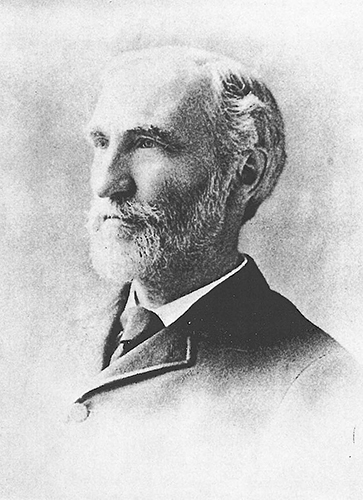 Also, in 1879, he was elected to the National Academy of Sciences. In 1881, he received the Rumford Medal from the American Academy of Arts and Sciences.
Also, in 1879, he was elected to the National Academy of Sciences. In 1881, he received the Rumford Medal from the American Academy of Arts and Sciences.
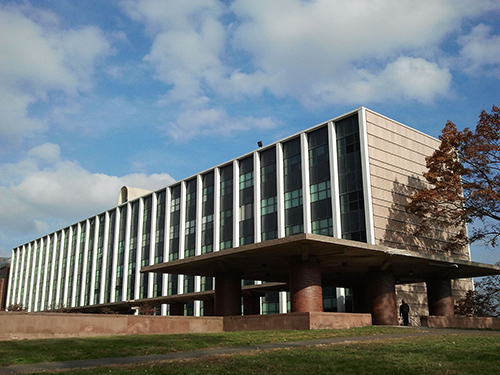 From 1881 to 1884, Gibbs worked on vector analysis which he improved with a new system of notation that advanced and simplified this mathematical method. Honorary degrees began to be awarded and in 1901 he received the Copley Medal, the highest award of the Royal Society in England. He was awarded honorary doctor degrees from Princeton and Williams College plus many European honors for his work in physics, chemistry, and mathematics.
From 1881 to 1884, Gibbs worked on vector analysis which he improved with a new system of notation that advanced and simplified this mathematical method. Honorary degrees began to be awarded and in 1901 he received the Copley Medal, the highest award of the Royal Society in England. He was awarded honorary doctor degrees from Princeton and Williams College plus many European honors for his work in physics, chemistry, and mathematics.
Willard Gibbs fundamental belief in simplicity and order created by a supreme being is similar to the beliefs of Isaac Newton and Albert Einstein. Gibbs, Newton, and Einstein all recognized the creative mechanisms of nature as the work of an almighty God. The order and functions they discovered in our universe reinforced their personal beliefs.
 Einstein recognized the genius of Willard Gibbs when he said, " (Gibbs was) "the greatest mind in American history."
Einstein recognized the genius of Willard Gibbs when he said, " (Gibbs was) "the greatest mind in American history."
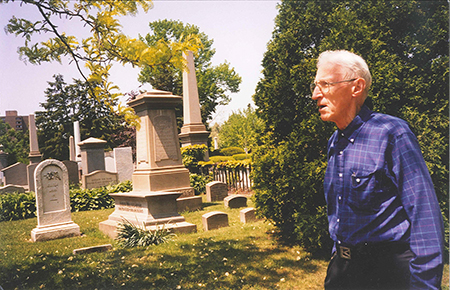 In 2005, the US Postal service held its first day of issue ceremony in Luce Hall on the Yale campus introducing commemorative stamps depicting "American Scientists." J. Willard Gibbs was the first of the series of four individuals which included John von Neumann, Barbara McClintock, and Richard Feynman. John Marburger, science advisor to the President, and Yale president Richard Levin adressed the attendees that included family members of the honorees. John W. Gibbs, a professor and distant cousin of Willard Gibbs also attended.
In 2005, the US Postal service held its first day of issue ceremony in Luce Hall on the Yale campus introducing commemorative stamps depicting "American Scientists." J. Willard Gibbs was the first of the series of four individuals which included John von Neumann, Barbara McClintock, and Richard Feynman. John Marburger, science advisor to the President, and Yale president Richard Levin adressed the attendees that included family members of the honorees. John W. Gibbs, a professor and distant cousin of Willard Gibbs also attended.
J. Willard Gibbs died in 1903 and is buried in the Gibb's family plot in New Haven's Grove Cemetery with his father and sisters.
Yale Engineering in the Post World War II Era
Published March 18, 2014
There is a surprising similarity between the Yale of the post war years following World War I and the post war years following World War II. In both instances, advances in military technology led to major changes in world order and the world economy during the peace-time decades following the end of the war. The challenge to universities, worldwide, was appropriate readjustment from a wartime environment to a peacetime community of higher education to prepare students to serve a global, peaceful world.
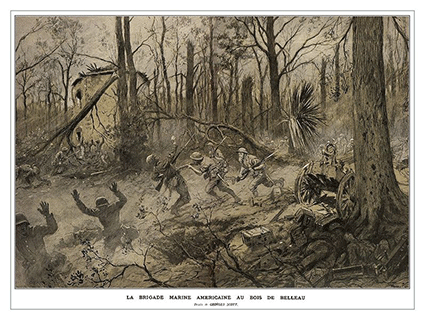 After WWI, the Yale administration moved aggressively to merge the Sheffield Scientific School with Yale College. The AC college emphasized liberal arts and traditional classical education while Sheff was the leading scientific-engineering school of its time. In 1919, a comprehensive study determined the most effective way to solve the duplication of courses offered by the two schools was to establish a mandatory freshman year for both AC and Sheff undergraduates.
After WWI, the Yale administration moved aggressively to merge the Sheffield Scientific School with Yale College. The AC college emphasized liberal arts and traditional classical education while Sheff was the leading scientific-engineering school of its time. In 1919, a comprehensive study determined the most effective way to solve the duplication of courses offered by the two schools was to establish a mandatory freshman year for both AC and Sheff undergraduates.
As a part of a comprehensive study of Yale curricula, the Sheffield governing board lost its ability to control the former autonomous and highly rated school of science and engineering leaving the Yale Corporation as the sole governing body. It took 13 years, until 1932, for Yale to reestablish a School of Engineering. The new school became a critical part of the change to a research university when Yale, Harvard, and other elite schools recognized the advantage of learning from research over the rote classroom learning taught in a classroom where teachers presented selected wisdom from the past.
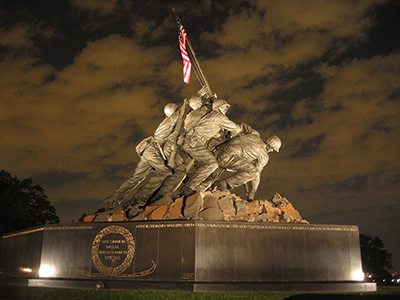 In 1951, in the post WWII era, the retirement of Charles Seymour as president, brought a new, young president, A. Whitney Griswold, to face the challenge of change. What followed was a series of studies focused on reorganizing the then School of Engineering by add- ing the teaching of applied science and liberal arts courses to the engineering curricula allegedly to accommodate the post-war changing times.
In 1951, in the post WWII era, the retirement of Charles Seymour as president, brought a new, young president, A. Whitney Griswold, to face the challenge of change. What followed was a series of studies focused on reorganizing the then School of Engineering by add- ing the teaching of applied science and liberal arts courses to the engineering curricula allegedly to accommodate the post-war changing times.
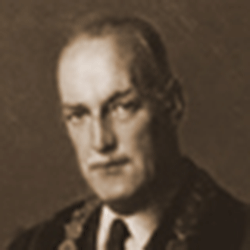 Also, in 1951, Yale faced rebuilding a decaying campus. Maintenance of classrooms and laboratory buildings, deferred during the depression and war years, put a high priority on renovating old buildings and building new when necessary. Inflation raised costs so prompt action was needed. Faculty salaries - long fixed - needed a fresh look and Yale would need alumni largess to rebuild the campus and balance a growing budget. While the Yale endowment actually grew during World War II years, inflation and a down stock market reduced current income squeezing future budgets.
Also, in 1951, Yale faced rebuilding a decaying campus. Maintenance of classrooms and laboratory buildings, deferred during the depression and war years, put a high priority on renovating old buildings and building new when necessary. Inflation raised costs so prompt action was needed. Faculty salaries - long fixed - needed a fresh look and Yale would need alumni largess to rebuild the campus and balance a growing budget. While the Yale endowment actually grew during World War II years, inflation and a down stock market reduced current income squeezing future budgets.
Griswold followed Seymour’s practice of forming study committees to bring a fresh look and broader participation to solve problems. The long delayed need for a fund drive required organization and an appropriate campaign theme to raise vitally needed funds.
Whitney Griswold exuded a determined personality with set values that resounded long after his sudden death in 1963. He was a committed liberal arts enthusiast who treasured liberal arts education as Yale’s mandate. However, he also realized that Yale was deficient in the sciences when compared to Harvard and other leading institutions so rebuilding old Sheffield buildings and adding new became a second priority. The Kline Science Center, a new physics building, the Gibbs Laboratories, and the expansion of Dunham Laboratory were positive Griswold moves designed to return Yale to a leadership position in science and engineering.
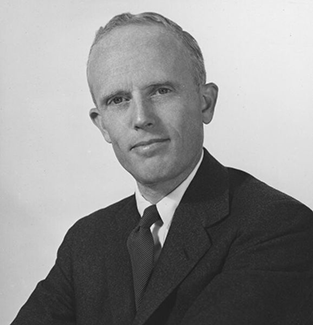 The new president’s often stated view of Yale’s reliance on liberal arts put him in opposition to “service station” programs that he viewed as trade school training unworthy of a Yale degree. Concluding that the Yale School of Nursing was trending towards a vocational school, he demanded a new curriculum and turned the nursing school into a graduate school which accepted only students with a bachelor’s degree. This upset alumni and the faculty of the nursing school which had no choice but to adopt his changes.
The new president’s often stated view of Yale’s reliance on liberal arts put him in opposition to “service station” programs that he viewed as trade school training unworthy of a Yale degree. Concluding that the Yale School of Nursing was trending towards a vocational school, he demanded a new curriculum and turned the nursing school into a graduate school which accepted only students with a bachelor’s degree. This upset alumni and the faculty of the nursing school which had no choice but to adopt his changes.
Griswold also concluded that the Yale Department of Education was a normal school unworthy of a Yale degree. He insisted that the department become a graduate school with a new program, so the undergraduate program faded away.
In the fall of 1960, after little progress in his concept of a “new engineering program” despite two study groups, Griswold formed a a third committee headed by Professor Barnett F. Dodge. Dodge was a notable chemical engineering professor who had been president of the American Society of Chemical Engineers. Dodge was nearing the end of his career, however, he delayed his Yale retirement to head the latest high level engineering study committee.
The report of this committee, “The study of Engineering Education at Yale University” was submitted to Griswold in October 1961. Despite unanimous support from the president and the Corporation and much positive reaction, confusion in the various engineering departments remained. An ongoing debate on the definition of scientist, applied scientist, and engineer split the science and engineering departments diverting them from their mission to build strong, attractive programs that would bring top students and superior faculty to Yale.
READ MORE ABOUT YALE ENGINEERING IN THE POST WORLD WAR II ERA»
How the Sheffield Scientific School Came to Be
Timothy Dwight IV, Benjamin Silliman, and Joseph Earl Sheffield bring the "New Education" to Yale
Published December 6, 2013 (Edited April 26, 2014)

In 1802, a new president,Timothy Dwight, acted to catch up with Harvard, Dartmouth, Princeton, and Pennsylvania who had established the first medical schools in the country. To lay the groundwork for a possible Yale Medical School, the first need was a professor of chemistry. So president Dwight approached one of his most gifted graduates, Benjamin Silliman, asking him to forsake a career in law, and accept the challenge to become Yale's first professor of chemistry.
Silliman, eager to establish himself, accepted the challenge. He first spent a year in Philadelphia where Benjamin Franklin's legacy of science and Joseph Priestly's presence had created institutions to support the new country in the sciences of electricity, the new chemistry, and medicine.
Priestly, although near the end of his long life, had brought his discovery of soda water and theory of various "airs" (gasses) to the New Country. Priestly's isolation of oxygen is considered the turning point in refocusing the science of chemistry as distinct from and superior to the older alchemy and its magic theories. Silliman met Priestly and quickly added new, current knowledge in his quest to understand the chemistry advance theories that he would need to teach chemistry at Yale.
After two years of study in Philadelphia, Silliman realizes that a trip to England and Scotland would be essential to his learning of the new sciences. In 1803, he persuades the Corporation to appropriate funds for apparatus, books, and his travel expenses for a very successful tour of the science centers of England.
He returns to New Haven in 1804 prepared for a life long journey that would build Yale and New Haven into a center of "new education." Silliman's contributions went beyond chemistry to include geology, mineralogy, and medicine -- fields of strength for Yale that underpin the present schools which are among the best in the higher educational world.
In 1806, President Dwight induces an established physician, surgeon, and educator at Dartmouth - Nathan Smith - to become Yale's professor of medicine. This necessary step helps Silliman in his task to include the Connecticut Medical Society as they prepare a constitution for a new medical school at Yale. With Silliman's leadership, in 1807, the joint committee begins its deliberations and, in 1810, the committee submits a proposed constitution to the Connecticut General Assembly. The legislature gives its approval and the Yale Medical Institution is established.
In 1834, Silliman began an extensive series of public lectures traveling about the new country. One commentator remarked about his geology lecture, " He was perfectly at home among the wreck and ruins of a former world, balancing a flood of waters and a lake of fire. He stands, like some kind but mighty spirit sent to instill into the minds of the rising generation the sublime and awful mysteries of the past creation, himself 'filled to bursting nigh' with the majesty and grandeur of the subject."
 Benjamin Silliman taught very popular and leading edge courses in geology, chemistry, and pharmacology. Students were choosing Yale over other institutions because New Haven had become a center of scientific learning. The Yale Corporation supported the "New Education" which was taught at a high level in the Yale schools of medicine, nursing, science, and engineering. All schools were expected to be financially self supporting.
Benjamin Silliman taught very popular and leading edge courses in geology, chemistry, and pharmacology. Students were choosing Yale over other institutions because New Haven had become a center of scientific learning. The Yale Corporation supported the "New Education" which was taught at a high level in the Yale schools of medicine, nursing, science, and engineering. All schools were expected to be financially self supporting.
In 1840, Silliman was asked by John A. Lowell to give the first public lecture at the new Lowell Institute in Boston which he had endowed with $250,000 to offer the people of New England, "Free lectures in science, literature and the arts." Silliman was introduced by Massachusetts Governor Everett as the leading scientist of his time. He continued to give regular lectures in Boston for four years. After his last lecture in 1843, he was named president of the American Association of Geologists and Naturalists, the predecessor of the American Association for the Advancement of Science.
Yale was again following Harvard who had established an advanced school of Science and Literature in 1846. This school, endowed by Abbott Lawrence, is named the Lawrence Scientific School in the University at Cambridge. Both the school at Harvard and the embryo school at Yale were, essentially, graduate schools which accepted students who had some college education elsewhere. New students in New Haven and Cambridge sought the latest education in science and technology to satisfy a growing need of the Industrial Revolution as it impacted the U.S. economy.
The Yale Corporation appointed John Pitcairn Norton as Professor of agricultural chemistry and Benjamin Silliman, Jr. as professor of practical chemistry in 1846. This decision established a separate science department at Yale. In the resolution there is a stipulation that no charges to the university are expected. Norton and assistant professor Benjamin Silliman, Jr. constructed a chemical laboratory in Farnum Hall. The Corporation decides, in 1847, then expands the scope of teaching into a Department of Philosophy and the Arts on a par with the departments of theology, medicine, and law. 1847 is the generally accepted birth date of a school of science at Yale.
The energy and ability of Norton succeeds in attracting many students and his proposal to the Corporation for granting a degree of Bachelor of Philosophy in chemistry in 1852 is accepted.
When J. P. Norton dies young at 40, the chemistry laboratory is taken over by John A. Porter who comes to Yale from Brown. (Silliman, Jr. accepts a post at the medical school of Louisville and leaves Yale.)
William A. Norton, is a graduate of the U.S. Military Academy, then professor of mathematics and Natural Philosophy at Delaware College for eleven years, and now, in 1852, he is professor of civil engineering at Brown University. But Norton is unhappy with the Brown administration and their refusal to support his program. He offers to move his students and himself to New Haven which John Porter enthusiastically supports. The Corporation agrees providing the school is self supporting.
Little change takes place for two years as Porter continues his work in chemistry and Norton accustoms his engineering students to New Haven and Yale. In 1854, the two departments are combined as the Yale Scientific School.
In 1855, Benjamin Silliman, Senior, moves to professor emeritus as James Dana assumes his duties as professor of natural history and also teaches a course in mineralogy and geology in the Yale Scientific School. Benjamin Silliman, Jr. returns to Yale. An important addition to the faculty is George J. Brush, a graduate of the Yale Scientific School class of 1852, who is now promoted to professor of metallurgy.
In 1856, James Dana returns from a geological expedition in the Pacific Ocean and at the Yale Commencement exercises, he argues for a more formal and well financed structure for the Yale Scientific School.
Dana repeats his arguments before a Yale alumni group in New York City and this is followed by a brochure signed by President Woolsey, Benjamin Silliman (Jr. & Sr.), James Dana, John Porter, and George Brush which enumerates the needs and advantages of an expanded school.
Yale finds its benefactor in Joseph Earl Sheffield.
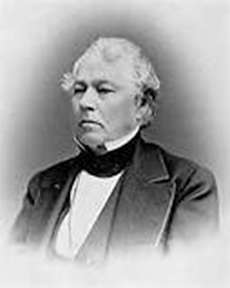 Joseph Earl Sheffield, born in Southport, CT in 1793, is the son of a ship builder and trader who sailed a privateer against the British in the War of Independence. In 1807, the fourteen year old Sheffield goes south to seek his fortune as an apprentice in a drug store in Newbern, NC. The South was a land of opportunity with cotton farming powering economic expansion which offered able businessmen the chance to prosper.
Joseph Earl Sheffield, born in Southport, CT in 1793, is the son of a ship builder and trader who sailed a privateer against the British in the War of Independence. In 1807, the fourteen year old Sheffield goes south to seek his fortune as an apprentice in a drug store in Newbern, NC. The South was a land of opportunity with cotton farming powering economic expansion which offered able businessmen the chance to prosper.
During the war of 1812, Sheffield, now with a trading house, twice successfully runs the British naval blockade of New York City at considerable profit. These successes are recognized by his superiors who promote him to full partner.
The end of the war in 1815 sees a decline in commodity prices which encourages Sheffield to move further south to the new port of Mobile, Alabama. He establishes trading routes between Mobile and New York City, Liverpool, and Le Havre. Sheffield remains in Mobile for 22 years building up his freight forwarding business in cotton and other in-demand southern goods.
In 1835, the "sickly climate" of Mobile proves unhealthy for Sheffield's wife. His concern for her health plus his abhorrence for slavery, impairs his ability to function in the South. These concerns are factors that encourage him to return to the northeast. He first spends summers in New Haven to escape the unhealthiness of a Mobile summer. His choice of New Haven for the next phase of his life was fortuitous for both the city and Yale College.
Sheffield accumulates sizable wealth though honest dealings and careful trading decisions. He builds a respected international reputation by adhering to ethical principles. As an eminent man of business, according to Yale President Noah Porter, "He was honorable from the convictions of his conscience and the sentiments of his heart."
Upon arriving in New Haven in 1835, Sheffield invests in the Farmington Canal which connects New Haven to Farmington, CT with plans to extend to Northampton, MA. When railroads replace canals as trade highways, Sheffield and his business partner, Henry Farnum, add a railroad line to the canal right-of-way.
Always looking for new business opportunities, Sheffield purchases the railroad rights-of-way between New Haven and New York City believing this would benefit New Haven and adjacent communities. When this investment proves successful, he moves west purchasing an essential right-of-way to connect New York City to Chicago. This enormously successful venture doubles the value of Chicago real estate. Sheffield follows with the creation of the Rock Island Railway and then builds a key bridge across the Mississippi River to open rail lines into the western interior of the country.
As Sheffield ages, he increasingly uses his wealth for good purposes. In 1855, his first donation to Yale was to Professor John Porter (his son-in-law) for a professorship in Analytical and Agricultural chemistry. Thereafter, Sheffield supports the "New Education" at Yale with "an unremitting flow" dedicated to technical and scientific fields.
In response to the first appeal for financial help on behalf of the Yale Scientific School, Sheffield purchases an old medical college building on the Yale campus near the Grove Street Cemetery. He enlarges the building and refits it before donating it to Yale as Sheffield Hall in 1860. In appreciation of Sheffield's continuous support, the Yale Corporation, in 1861 renames the Yale Scientific School, the Sheffield Scientific School despite Sheffield's personal reluctance for any sign of personal aggrandizement.
In 1866, the State of Connecticut grants $135,000 to the Sheffield Scientific School which encourages Sheffield to enlarge Sheffield Hall and donate $10,000 for a library. In 1871, Sheffield gives land and money for a second scientific building, North Sheffield Hall. His contributions to Yale continue and total about one million dollars - the largest private donations to the college up to that time. He never asks for special control or puts limitations on his donations -- always expressing full confidence in the Yale officials who receive his gifts.
After his death in 1881, his remaining estate is divided between the Sheffield Scientific School and his children. His wife completes the family donations when she bequeathes her Sheffield Hillhouse mansion to Yale.
In addition to his contributions to Yale, Sheffield supported Trinity College - as a trustee and benefactor - and, also, the Berkeley Divinity School then located in Middletown, CT.
Sheffield had a life long sympathy for the aged and disadvantaged - almost never turning away a beggar's hand. According to President Porter, "He provided first a hospital for the aged, a school of charity for the young, a church for the poor, and a great school of science and culture which widened and enhanced the reputation of the college and of the city itself."
President Porter observed, "Mr. Sheffield began his benefactions from a personal conviction of the value and promise of a tentative school which was then regarded only as an offshoot of a great university. It grew in his esteem and confidence as he witnessed its well-earned success by honorable methods, on a basis of honest work."
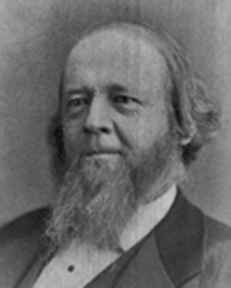 "Mr. Sheffield set the highest value upon a liberal education to develop and mature the student, and for this reason he supported schools of learning with such lavish liberality. He may, in some respects, have builded more wisely than he knew, but it was altogether in harmony with his judgment that the school which bears his name, early became more than a school of special skill and limited research and was lifted up with a college of liberal culture which aims as specifically to discipline the intellect and character as it does to impact technical knowledge and skill."
"Mr. Sheffield set the highest value upon a liberal education to develop and mature the student, and for this reason he supported schools of learning with such lavish liberality. He may, in some respects, have builded more wisely than he knew, but it was altogether in harmony with his judgment that the school which bears his name, early became more than a school of special skill and limited research and was lifted up with a college of liberal culture which aims as specifically to discipline the intellect and character as it does to impact technical knowledge and skill."
We remain forever in James Earl Sheffield's debt for his foresight and munificence in creating a lasting spring of knowledge that benefits Yale and the world.
Our indebtedness also must acknowledge the foresight of President Timothy Dwight who detected the absolute need to be in the leadership of the awakening of the science of chemistry and its ramification for the advance of medicine and other fields of scientific inquiry.
The willingness of Benjamin Silliman's son to follow his father's career also greatly contributed to the reputation of the Yale Sheffield Scientific School. Benjamin Silliman Jr. was a key contributor to the world's first oil boom when he determined that Pennsylvania "rock oil" had many useful applications. The US quickly became the world leader in the global oil industry.
Benjamin Silliman
The Yale Science & Engineering Association, is one of Yale’s oldest alumni organizations. Founded in 1914 as the Yale Engineering Association, science alumni were added in 1971. The YSEA will celebrate its centennial anniversary in 2014 with various projects including an updated history of Yale science and engineering containing this profile of Benjamin Silliman.
After his appointment as professor of chemistry in 1804, Silliman expanded his studies and teaching into geology, mineralogy, medicine, pharmacology, astronomy, and engineering. Silliman helped New Haven and Yale become the scientific center of the young United States. He contributed to the formation of the Yale Medical Institution in 1813. The geology department, and publication of the American Journal of Science in 1818 were his creations. He became an apostle of science spreading his knowledge by lectures, text books, and associations. Near the end of his life, he was a founder of the Yale Scientific School.
Published February 19, 2013
At the height of the War for Independence in April 1777, British ships attacked south of Fairfield, Connecticut launching an inland raid to destroy colonial military supplies in Danbury. Gold Seleck Silliman, father of Benjamin Silliman and general in charge of troops tasked to defend Connecticut and southeastern New York State, responded by harassing the British professional army.
In May, 1779, in the dead of night, Torrey raiders from Long Island, assisted by Fairfield loyalists, captured Seleck Silliman and his son, William, spiriting them across the Sound to Long Island where they were held prisoners for a year.
Mary Silliman, fearing that the capture of her husband was prelude to an attack on Fairfield, fled inland to Trumbull, CT where she gave birth to her second son, Benjamin. In July 1779 the British did return to burn the town of Fairfield.
The first Silliman to immigrate to Fairfield was Daniel Silliman -- a religious refugee whose ancestors came from northern Italy. Daniel moved to Holland with other dissidents who eventually sought asylum in the new world. He settled on a hill in Fairfield, built a large house with views of the Long Island Sound which is known as Holland Hill.
Benjamin’s father and grandfather both graduated from Yale College and both were lawyers. Grandfather Daniel was a Connecticut Supreme Court justice and his father, Seleck, became an effective general in the revolutionary army.
Silliman's student years
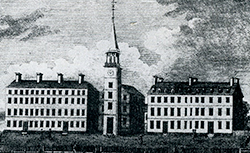 Benjamin Silliman entered Yale at thirteen, graduating near the top of his class in 1796. After graduation, following the family tradition, he studied law before returning to Yale as a tutor in 1799. In 1802, Yale president Timothy Dwight was bent on advancing Yale studies into secular areas. Harvard, Dartmouth, Princeton, and Penn had professors of chemistry and these colleges formed departments or schools for medical education.
Benjamin Silliman entered Yale at thirteen, graduating near the top of his class in 1796. After graduation, following the family tradition, he studied law before returning to Yale as a tutor in 1799. In 1802, Yale president Timothy Dwight was bent on advancing Yale studies into secular areas. Harvard, Dartmouth, Princeton, and Penn had professors of chemistry and these colleges formed departments or schools for medical education. 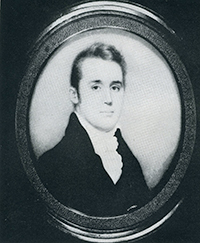
Dwight asked Silliman to forego becoming a lawyer - there was a surplus of practitioners in Connecticut - and learn all he could about the new science of chemistry. If he was willing, he would be appointed Yale’s first professor of chemistry. Dwight’s persuasive argument was, “Our country, as regards the physical sciences, is rich in unexplored treasures, and by aiding in their development, you will perform an important service and connect your name with the rising reputation of our native land.”
Yale at the turn of the century
The start of the 19th century was an exciting time for the new United States. The country grew rapidly and, the consensus among forward thinkers, was that rich natural resources and unexplored lands offered rare prospects. Growing cities and unexplored mineral riches would create new opportunities. The Age of Enlightenment expanded man’s vision as scientific learning and new inventions offered longer life and better living conditions to millions of people.
When Yale residential colleges were built in 1933, both Timothy Dwight and Benjamin Silliman were chosen as Yale legends worthy of a college name. These colleges are forever linked abutting each other on the site of the Sheffield Scientific School southeast of Grove Cemetery.
President Dwight realized that Yale must lead in secular areas and a chemistry course was necessary to keep pace or outpace Harvard and others. Yale must act and Dwight chose Benjamin Silliman for his outstanding scholarship, his good pedigree, and his total commitment to Yale. Dwight argument that there were many lawyers in Connecticut, but no accomplished chemists was persuasive. By accepting this challenge, Silliman would become Yale’s first professor of chemistry and his success would reward him handsomely as he helped the new country grow and prosper by applying the scientific principles he taught.
Benjamin Silliman's great challenge
Silliman first studied in Philadelphia in 1802 with the country’s leading chemistry professor, James Woodhouse, of the Medical School of Philadelphia. He was diligent in attending Woodhouse’s lectures and he met the famous Joseph Priestley, the discoverer of oxygen and a pioneer in chemistry. He became a close friend of Robert Hare, son of a wealthy brewer, who built a laboratory in their rooming house basement where they conducted their own experiments.
In 1803, Silliman spent a second winter in Philadelphia detouring to meet professor John Maclean, a Scotsman and chemistry professor at Princeton. In reflecting in later years, Silliman traces his approach to teaching chemistry to his interaction with Maclean who opened his laboratory and library to him with wit and brilliance.
In April, 1804, Silliman gave his first lecture at Yale on chemistry to the senior class using his accumulated apparatus and chemicals to illustrate various phenomena. Thus began a fifty-six year career as professor and expert in the new science of chemistry. In a short time, he raised Yale College to be a leading source of knowledge in a western world-- not only in chemistry -- but also in geology, mineralogy, astronomy, and medicine.
Silliman’s first European adventure
Silliman realized that the seat of new learning in the developing sciences was in Europe, particularly England and France. With the support of the Yale Corporation and a financial stipend of $9,000, in 1805, Silliman carefully planned his trip to Europe. Before leaving, he spent time in New York City with Benjamin Perkins who had accumulated a small “cabinet” of rock specimens. Perkins gave him letters of introductions to numerous scientific leaders in England. Thus began, Silliman’s introduction into the emerging science of geology.
Silliman sailed to Europe intent on increasing his proficiency in chemistry while also purchasing books and chemical apparatus for Yale. He would expand his knowledge by contact with many leaders in the natural sciences including medicine. His success, as chemistry professor, would establish Yale as a center of scientific knowledge in the new world.
Using his letters of introduction to English, Scottish, and European intellectual leaders and natural scientists, he became friends and correspondent with many leading European scientists. Through letters and personal meetings, he became conversant with the latest European discoveries and newest scientific theories. He increased his personal knowledge base to prepare courses and lectures that he effectively presented to Yale students and the general public.
In Edinburgh, he learned of conflicting theories of the earth’s formation and evolution. A. G. Werner of Freiburg, Germany, eloquently proposed a theory of geology based on two great floods, as described in the Bible. Werner saw these massive oceans as the mechanism of the earth’s rock crust formation. James Hutton, a Scotsman, disputed Werner’s claim that the earth was quite young - perhaps 5000 years old. Hutton saw evidence of a most ancient world that continued to evolve from fire beneath the surface. Fascination with rocks and the new science of geology stimulated Silliman to collect rocks to illustrate his lectures on the composition of the earth’s crust. Silliman expanded his knowledge beyond chemistry to include the new fields of geology and mineralogy.
Expanding his science studies, Silliman attended lectures at Edinburgh University in medicine, materia medica (pharmacology), anatomy, and mineralogy. He read Scottish science journals which later encouraged him to form the American Journal of Science.
An invigorated Silliman returns to Yale
Silliman returned to New Haven and Yale College in June 1806 with chemical apparatus, a science library, copious notes of his interviews, a travel journal, and a meticulous record of all expenses. The Corporation accepted his return with appreciation and approved his expenses with thanks.
He quickly resumed his work as professor of chemistry preparing a series of well-attended lectures to which he added geology. With the cooperation of the Corporation and president Dwight, he oversaw the building of a chemical laboratory and lecture hall.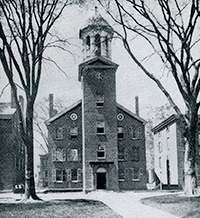
When Silliman noted similarities between East and West Rock in New Haven and Salisbury Craig, a cliff near Edinburgh, he hiked the nearby cliffs accumulating rocks to compare them with those found in Scotland. This geological study in mineralogy resulted in a well received presentation to the Connecticut Academy of Arts and Sciences in September 1806.
On vacation in Providence, RI to visit his brother, Selleck, he was introduced to Colonel George Gibbs who had amassed a large collection of European rocks. Silliman was fascinated by the size and great variety which Gibbs had in storage in a Newport warehouse.
Yale explores founding a Medical Institution
In 1806, President Dwight presented a resolution to the Corporation for a new appointment -- professor of medicine. A special committee -- President Dwight, Benjamin Silliman and Nathan Strong -- was appointed to explore the creation of a Yale Medical Institution. Because the State of Connecticut had a powerful Medical Society which licensed doctors, the college committee needed a harmonious relationship with them. Silliman was an effective negotiator who found common interests between Yale’s ideas for a medical school and the Societies commitment to quality medicine. In the autumn of 1807, the joint committee produced a constitution for a medical institution at Yale that satisfied both the College and the Medical Society.
In October 1807, Silliman began lectures in chemistry and added lectures on the contemporary sciences of the time. To support his lectures in chemistry, he published an American edition of Henry’s, “An Epitome of Chemistry” complete with his own notes now adapting the text to his chemistry lectures.
His students had little concept of scientific learning as their Yale education was primarily classical and ecclesiastical. Silliman evolved a practical style with boyish enthusiasm and many experiments. When teaching chemistry, he often diverted to geology to emphasize a point. His rock collection spiked interest in geology and he is credited as the first to lecture on the new field of geology in America. His reputation as an accomplished, enthusiastic teacher grew as his classes became popular and effective.
Yale becomes a geology center
Silliman expanded his small European rock collection adding rocks from New England. He bought Benjamin Perkins’ rock collection for $1000. He resumed his contacts with Colonel Gibbs in Rhode Island and he traveled to Boston to see what was new at Harvard. He concluded that, “there was not much spirit of science in Boston.”
With his expanded Yale collection as a useful display, Silliman offered Yale’s first course in mineralogy. Students paid a small ticket price for the course which became very popular. With this success, Silliman introduced the concept of elective courses to Yale.
1807 was a special year for Silliman as December brought the Weston Meteor which lit up the sky from Canada to Connecticut. Now, his interest in astronomy interfaced with his knowledge of chemistry. Silliman bought fragments of the meteor from a farmer in Weston and performed a quantitative chemical analysis of its contents. At that time, the source of meteors was unknown. Theories abounded that they could be chunks of earth, parts of the moon, or particles from outer space. His chemical analysis was published by the American Philosophical Society and science societies in England and France. Silliman was now notable as a general scientist willing to explore all areas of human knowledge.
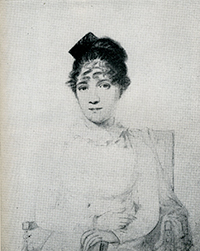 In 1808, Silliman’s notoriety and his recognized excellence as a science expert brought a suggestion from President Dwight that he modify his basic chemistry lecture for presentation to the general public. Silliman responded positively and invited Harriet Trumbull (daughter of the governor) to his first New Haven public lecture.
In 1808, Silliman’s notoriety and his recognized excellence as a science expert brought a suggestion from President Dwight that he modify his basic chemistry lecture for presentation to the general public. Silliman responded positively and invited Harriet Trumbull (daughter of the governor) to his first New Haven public lecture. 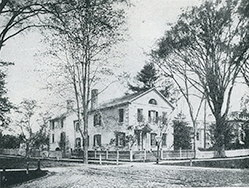
Young men of his time needed a modicum of success before proposing marriage to a woman of the gentry. Silliman now could see a bright future: his success at Yale was established, his European travel journal was about to be published, and his report on the composition of the Weston meteor brought international recognition. A year later, Benjamin and Harriet were married and soon the young Sillimans built a substantial house on Hillhouse Avenue to accommodate a growing family.
Silliman ventures into business
In 1809 he partnered with Stephen Twining and other Yale friends to take advantage of a growing business prospect. His Philadelphia friend Priestly discovered that a popular spa at Pyrmont in England consisted of water impregnated with carbon dioxide. Silliman purchased equipment from Philadelphia which enabled him to make similar “soda water.”
The public demand for health giving “spa soda water” was exploding. While demand in Connecticut was limited, the fad was escalating in New York City. Silliman and partners competed intensely with Usher from Philadelphia. Both tried to build a profitable business by enticing New York Society into “soda fountains” to enjoy healthful benefits from man-made spa waters. Hope for a quick profit faded when the fad subsided and manufacturing problems arose. Silliman’s process used wooden casks specially made to hold the pressurized waters. Usher developed copper tanks which could withstand the high pressure while Silliman’s wooden casks leaked.
While business success in soda water faded, Silliman’s travel journal of his experiences in England, Scotland, and the Continent drew rave reviews from relatives and friends. Author’s had to finance the cost of book publishing, a cost that Silliman could not bear. When Daniel Wadsworth of Hartford, a man of means, asked to meet him, with suggestions on organizing the journal’s content and editing, Silliman responded positively. Wadsworth saw good market potential in England and America. Silliman and Wadsworth became close friends as they edited the manuscript for publication.
His growing reputation brought inquiries from investors who sought help in accessing the natural resources of the new country. His analysis of mineral and ore deposits provided an additional source of income. In 1810, his first commission -- a survey of a lead mine in Massachusetts -- earned him $50 in gold for his study and report.
The Yale Medical Institution is formed
In 1810, the Connecticut General Assembly approved an Act of Incorporation for the Yale Medical Institution. Yale now needed a course of study, facilities, and new professors and instructors. The school also would benefit by appointing a person of high repute to lead it. Dr. Nathan Smith, currently at Dartmouth, was the ideal choice: an experienced administrator, a renowned teacher, and recognized medical investigator.
At Commencement 1813, Dr. Smith was appointed Professor of Theory and Practice of Physic, Surgery, and Obstetrics along with Drs. Munson, and Ives of New Haven, and Benjamin Silliman, professor of Chemistry and Pharmacy, with Jonathan Knight as Professor of Anatomy. The Medical Institution opened in the fall with thirty-seven students.
The Gibbs Cabinet and Yale Geology
Silliman reconnected with Colonel Gibbs who was seeking an exhibit space for his extensive European rock collection at the U.S. Military Academy in West Point. No adequate space could be found. Gibbs was frustrated by lack of interest in Boston, New York, and Philadelphia. Gibbs asked Silliman for help in displaying his extensive collection in New Haven.
Silliman proposed to President Dwight that the second floor of South Middle College be renovated as a large display room for the Gibbs “Cabinet.” Dwight and the Corporation supported the project and Silliman, working with the college carpenter, designed and built glazed display shelves that attractively displayed the complete Gibbs collection.
The Gibbs cabinet became a powerful attraction for visitors to New Haven. The superb presentment of the rocks of Europe and other far off places made a dazzling display. Formal opening ceremonies were held on June 12, 1812, the very day that war was declared between the U.S. and Britain. Despite this distraction, the opening took place with many visitors and a well pleased Colonel Gibbs in attendance.
The War of 1812 was unpopular in New England. While the contentious point was freedom of the oceans and New England states were deeply involved in seafaring commerce, most northeast political leaders were fearful that an attack on Canada would bring reprisals by the British who would mount raids on their exposed seaports. At Yale, students mustered in military companies to protect New Haven. The memory of the British attack on New Haven in 1779 was fresh in mind.
President Timothy Dwight died in 1817. Silliman was asked to give the funeral oration and he also was a candidate to succeed Dwight as Yale president. However, the Corporation was not yet ready to break the succession of Congregational ministers who were Yale leaders from the beginning. Jeremiah Day, a close friend of Silliman, was appointed Dwight’s successor as Yale’s 9th president.
Founding the American Journal of Science
Silliman and other friends were contributors to Bruce’s American Mineralogical Journal, the first of its kind in the new country. When Archibald Bruce became ill in 1817, the annual issue was unlikely to be published. George Gibbs, at a chance meeting crossing the Sound, suggested that Silliman edit the next issue. Bruce willingly agreed and at the urging of another geologist and friend, Parker Cleaveland, Silliman responded positively. He corresponded with many of his other geology-minded friends and by 1818, he found a printer and enough subscribers to launch the American Journal of Science and Arts with a first printing of 500. Silliman broadened the scope of the journal beyond geology attempting to meet the high standards of European scientific journals.
The success of the Gibbs rock collection displayed at Yale, the publishing of Silliman’s travel journal, his popular lectures on chemistry together with his affiliation at the Yale Medical School raised Benjamin Silliman to a man of renown in the scientific world of his time. George Gibbs, now a close friend, proposed that he form an American Society of Mineralogy and Geology. Silliman, with Gibbs and Cleaveland supporting him, agreed. In May 1819, Silliman shepherded a charter, presented by Gibbs, through the Connecticut Assembly with he, Gibbs, Cleaveland, and other friends as directors. (This Journal is still published by the Yale Geology Department.)
Founding the Yale Art Gallery
 For many years, Benjamin Silliman had known Colonel John Trumbull (formerly an aide to General George Washington) as his wife’s uncle. After the war in 1778, Trumbull went to England to study painting with Benjamin West. His eight historical paintings of the Revolutionary War had been duplicated “at great personal expense” in the hopes that the paintings and engravings would be widely popular. In 1830, Silliman met Trumbull, in his New York City apartment finding him despondent and in dire financial straits because of his lack of success in selling his Revolutionary War art. Trumbull was angered at the lack of patriotic ardor of the present generation. He now offered all his art (originals and engravings) to Yale for a life time annuity of $1000 per year.
For many years, Benjamin Silliman had known Colonel John Trumbull (formerly an aide to General George Washington) as his wife’s uncle. After the war in 1778, Trumbull went to England to study painting with Benjamin West. His eight historical paintings of the Revolutionary War had been duplicated “at great personal expense” in the hopes that the paintings and engravings would be widely popular. In 1830, Silliman met Trumbull, in his New York City apartment finding him despondent and in dire financial straits because of his lack of success in selling his Revolutionary War art. Trumbull was angered at the lack of patriotic ardor of the present generation. He now offered all his art (originals and engravings) to Yale for a life time annuity of $1000 per year.
Silliman, always ready to act on behalf of Yale and its reputation as a leading intellectual community, proposed to new president Jeremiah Day that Yale accept this offer. Day was enthusiastic. Trumbull then thought he might divide the collection between New Haven and Hartford, with Daniel Wadsworth, another close friend of Trumbull, as the proposed Hartford recipient. Silliman received pledges of support for Trumbull’s annual $1000 stipend from Day, Goodrich, Twining, and himself. Also Wadsworth accepted that the collection should stay together in New Haven, and he joined the other contributors to Trumbull’s maintenance.
To house the paintings, Silliman approached the Connecticut State Assembly for funds to erect a building on the Yale campus. With the support of two Yale alumni, who were also legislators, Truman Smith and Judge Romeo Lowry, the legislature approved $7000 for the building. Silliman oversaw the construction with the help of the Yale treasurer at a cost of $5000.
Colonel Trumbull helped select furnishings and guided the design of the “chastely classical” building. Trumbull brought all his paintings and engravings by packet ship from New York (the steamer company offered free passage). The grand opening for the Trumbull collection in the new and the first college art gallery in the country took place in October 1832. Benjamin Silliman was the first curator of the Yale Art Gallery. Jonathan Trumbull wished to be buried beneath the gallery, so upon his death in November 1843, Silliman, the executor of his will, “deposited his body in its last resting place.”
Benjamin Silliman as traveling lecturer and consultant
Over the next years, until his semi-retirement from teaching in 1833, Silliman displayed an exceptional skill at teaching chemistry, geology, mineralogy, and general science that encouraged students to choose careers in science.
For his own information, Silliman prepared a roster of assistants and pupils who became notable professors, lawyers, physicians, editors, and the founder of RPI (Ames Eaton.) This remarkable chronology of achievers helped elevate the young country to global recognition. Timothy Dwight’s prediction, in 1802, that Silliman could earn international repute by helping the young country become a bastion of new knowledge became reality.
In 1834, when Silliman began his long lasting series of public lectures traveling about the new country. One commenter remarked about his lecture on geology, “ He was perfectly at home among the wreck and ruins of a former world, balancing a flood of waters and a lake of fire. He stands, like some kind but mighty spirit sent to instill into the minds of the rising generation the sublime and awful mysteries of the past creation, himself ‘filled to bursting nigh’ with the majesty and grandeur of the subject.”
In 1840, Silliman was asked by John A. Lowell to give the first public lecture at the new Lowell Institute which he had endowed with $250,000 to offer the people of New England free lectures in “science, literature and the arts.” Silliman was introduced by Massachusetts Governor Everett as the leading scientist of his time and he continued to give regular lectures in Boston for four years. After his last lecture in 1843, he was named president of the American Association of Geologists and Naturalists, the predecessor of the American Association for the Advancement of Science.
In 1846 President Day, after 30 years in office, resigned because of failing health. Again, Silliman’s name was put forward by friends as a worthy successor as president of Yale. Silliman correctly read the feelings of the Corporation. Yale had always had Congregational ministers as presidents and they were unlikely to change that tradition. Also, science was viewed as a threat to liberal arts by many professors. His outstanding success at bringing popular new sciences to Yale was not viewed unanimously as a good measure.
With some personal reservations, Professor Theodore Dwight Woolsey accepted the mantel of Yale president. Woolsey prime interest was in ecclesiastical research. He was content to leave his strong administrators as the forward movers of the college in their separate areas. Silliman continued his classes and public lectures on behalf of Yale science until his death on Thanksgiving Day 1864.
In 1849 he received an honorary membership in the Smithsonian Institute and in 1851 he gave two lectures in Washington.
Silliman was one of the first American mining consultants as “forward-looking men” sought professional advice on mineral deposits. In the 1830s and 1840s, he traveled widely, sometimes in dangerous territory, to evaluate potential valuable ores. He examined the coal-rich Wyoming Valley in Pennsylvania, gold mines in Virginia, and iron ore deposits in Illinois. His last consultancy, in 1855, was in Virginia when he and Benjamin, Jr. investigated a vein of copper in the Blue Ridge Mountains.
In 1851, with six month leave granted from his college duties, he returned to Europe with his son Benjamin Silliman, Jr. and others. This time, travel was on the S.S. Baltic, a steam engine powered side wheeler mail boat that made the crossing in eleven days. He reconnected with his English correspondents as an old friend. He found Oxford well behind Yale in its knowledge of geography, chemistry, and sciences in general - still mired in the classical education of the past. In the French Academy, he found the true center of the European world of science and met many distinguished scientists, geologists, and physicians. Traveling to Italy, he climbed Mt. Vesuvius, saw Stromboli, and climbed part way up Mt. Etna marveling at these active volcanoes still forming the crust of the earth. Next he traveled through Switzerland to Berlin where he attended the Geographical Society. He visited Heidelberg and the School of Mines at Freiburg, home of Abraham Werner, the famous geologist whose theory of the earth’s creation was now supplanted as the new science of geology widely accepted Hutton’s theory of the earth’s formation.
Silliman’s suasions - Sheffield Scientific and the Peabody museum
Silliman attempted to retire in 1853, however, the Corporation granted him professor emeritus status and asked Silliman to continue his lectures in Mineralogy and Geology. Benjamin Silliman, Jr., his son, became Professor of General and Applied Chemistry with a joint assignment to the medical Institution - a position that Silliman had held from its inception in 1813.
Silliman’s protege and personal assistant, James Dwight Dana, who had come to Yale to study geology under Silliman’s tutelage in 1835, completed a brief study entitled, A System of Mineralogy. In book form, it was enthusiastically accepted as a seminal work of geology in both America and Europe. Dana then spent four years in the South Pacific studying the major islands of the Pacific Ocean. In 1844, he returned to New Haven and married Henrietta Silliman, Benjamin’s third daughter. In 1856, he took over most of the aging Silliman’s duties. In his introductory speech he lauded Silliman as the creator of the science of geology in America - an enviable position where Yale still maintains its international leadership.
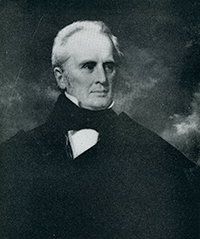 In 1846, Silliman and his son Benjamin, Jr. created two additional chairs in science: agricultural chemistry and vegetable physiology. These courses would essentially be advanced courses or graduate studies. Yale was moving to become the first to offer advanced degrees. In 1847 the School of Applied Chemistry became the Department of Philosophy and the Arts which would eventually become the Yale Graduate School. The specific program proposed to the Corporation was for two new professors, but the underlying argument was a new venture in scientific education because the professors appointed had no undergraduate duties.
In 1846, Silliman and his son Benjamin, Jr. created two additional chairs in science: agricultural chemistry and vegetable physiology. These courses would essentially be advanced courses or graduate studies. Yale was moving to become the first to offer advanced degrees. In 1847 the School of Applied Chemistry became the Department of Philosophy and the Arts which would eventually become the Yale Graduate School. The specific program proposed to the Corporation was for two new professors, but the underlying argument was a new venture in scientific education because the professors appointed had no undergraduate duties.
In 1852, William Augustus Norton was named professor of civil engineering which is now considered the beginning of engineering at Yale.
In 1857, George Peabody came to Yale to visit his nephew Othniel Marsh, a sophomore in the class of 1859. Silliman met with Peabody suggesting he might be interested in supporting the new Yale Scientific School. Marsh became interested in the school taking post graduate courses. In 1863, Peabody donated $100,000 for the promotion of Natural Science at Yale selecting Benjamin Silliman as one of the trustees of his legacy.
The Silliman Legacy
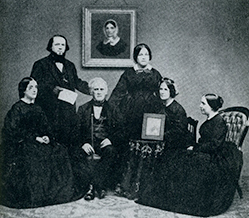 Benjamin Silliman died on Thanksgiving Day, November 24, 1864 at the age of 85 years - a long illustrious life of service to God, Yale, and Country.
Benjamin Silliman died on Thanksgiving Day, November 24, 1864 at the age of 85 years - a long illustrious life of service to God, Yale, and Country.
He was an exemplary teacher of science, however, he spent little time in laboratory research. He used vials and flasks for experiments that would later demonstrate a chemical reaction in a lecture that entranced his students.
His expansive connections to men of science across the western world was useful and contributed to his knowledge of new theories and innovations. Scientific knowledge was moving forward, and the world would be forever changed as people craved the newest, the healthiest, and improvements at the crest of the industrial revolution wave.
He was an exceptional conciliator able to weld a strong Congregational creed to the open eyed acceptance of scientific fact. An all-knowing God was now enlightening mankind to the great mysterious of His universe. Werner and Hutton, geological theorists, were both correct (in part), so Silliman walked between the two to attract all. This was his style, his personality, his greatness to always seek common ground.
In an obituary published a few days after his demise, Daniel Gilman concluded, “Professor Silliman had the rare magnetic power of kindling enthusiasm and awakening cooperation of all whom he wished to reach. He was kind of heart, clear of head, sympathetic, courteous, sagacious, and enterprising that (earned him) affectionate admiration, unqualified respect, veneration, and gratitude (from) pupils and friends through the length and breadth of the land.”
Benjamin Silliman, Jr., was one of many scientists who became Silliman’s legatees. His son inherited his father’s professorship and the good will of many. Silliman, Jr.’s greatest achievement was his analysis of Pennsylvania “rock oil” concluding that it would be useful as an illuminant and lubricant. Based on his conclusions, the first oil boom in the world occurred in Oil City, Pennsylvania and the age of petroleum emerged.
The Sheffield School at Yale University became the leading United States source of scientific and engineering studies during the Industrial Age.
Acknowledgements
George P. Fisher, Life of Benjamin Silliman, New York, 1866
Fulton & Thomas, Silliman, NY, 1947
Chandos Michael Brown, Benjamin Silliman, Princeton Univrsity Press, 1989
B. M. Kelley, Yale, A History, Yale University Press, 1974
Ezra Stiles
The 8th President of Yale University
1778 to 1795
Published May 4, 2012
Ezra Stiles will become the center of a trio of presidents that create a university of world renown at Yale. Beginning with Thomas Clap’s creative expansion of Yale into secular Enlightenment courses in mathematics and natural philosophy, Yale would turn from a seminary for Congregational ministers to a seat of knowledge for secular education in science and the humanities. Stiles would expand language education both in English and in Hebrew. He would allow belle lettres and dramatics to flourish. He was energetic in adding courses in Newtonian physics and astronomy.
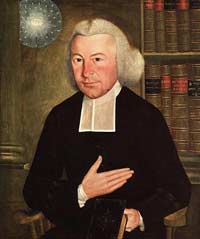 During the second half of the 18th century, Yale emerges under Clap, Stiles, and Dwight, as the premier school of higher education in the colonies produce strong intellectuals that implement the remarkable achievements of the Constitutional Congress of 1787. The United States of America becomes the world’s first government with a written republican constitution that successfully replace a monarchy.
During the second half of the 18th century, Yale emerges under Clap, Stiles, and Dwight, as the premier school of higher education in the colonies produce strong intellectuals that implement the remarkable achievements of the Constitutional Congress of 1787. The United States of America becomes the world’s first government with a written republican constitution that successfully replace a monarchy.
Ezra Stiles grandfather, John Stiles was among the first settlers of Windsor, CT. Ezra’s father, Isaac, after graduating from Yale in 1722, became minister of the North Haven Congregational Church and now lived on a 100 acre family farm.
Since his mother, Kezia Taylor, was daughter of a minister from Westfield, MA and because his father had a Yale degree, Ezra would learn Latin and Greek and look to Yale for his future education.
Stiles entered Yale at fifteen in 1742. The Great Awakening was then two years old and the Congregational Church in Connecticut was harassed and divided. Father Isaac Stiles joined Jonathan Edwards to offer alternatives to George Whitefield’s appealing call for repentance. After Whitefield left New England, Connecticut was assaulted by traveling evangelists who attacked Connecticut Congregational church leaders with questions about the validity of their ordinations. Ministers split into Old Lights, who were conservative Calvinists, and New Lights, who agreed with Whitefield, that the church needed radical change. Isaac Stiles, Jonathan Edwards, and Yale president Thomas Clap, emerged as leaders of the Old Lights.
Clap, in his 26 years of service as Yale president, engineered major changes in the Yale curriculum. He introduced required mathematics courses, advanced teaching of Natural Philosophy, (including lectures in astronomy and medicine), and he lectured on Common Law. Yale was transiting from a school designed to educate Congregational ministers to a broader curriculum that offered young intellectuals options that served a secular world. The rapidly growing colonies needed leaders in government, academics, law, and medicine. Ezra Stiles’ future, as Yale president, would be to change Yale from a Congregational seminary for intelligent youth to a university for educating leaders of a new country.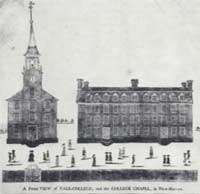
Ezra Stiles’ years at Yale as an undergraduate and tutor inflamed his curiosity for research in multiple areas. His tolerant disposition and impressive intellect earned him a reputation as an American intellectual. Unlike his father and unlike his mentor, President Thomas Clap, he avoided confrontations. He was a listener and correspondent who built close relations with numerous intellectuals in the colonies and in Europe. He believed in the effectiveness of associations and in ceremony and rituals. He suppressed a tendency to vanity. He was most pleased when Benjamin Franklin recommended him for an honorary doctorate from the University of Edinburgh which gave him a title - Doctor Stiles - which he treasured for the rest of his life.
Stiles’ years at Yale were lived with major background issues of religious turmoil and political unrest. Enlightenment beliefs contrasted with traditional teaching and new Yale graduates often challenged their superiors - particularly those bound by ancient traditions of learning. Stiles’ readings included George Berkeley and Isaac Newton whose views of our universe were contradictory. The lasting impact of his Yale education was development of an open mind willing to contemplate any well-reasoned argument. He tolerated well conflicting ideas and very seldom reacted with anger.
Ezra Stiles presented the class oration of 1746 on the subject: The king is not a divine authority. After graduation, Clap elevated Stiles to tutor and he spent the next 3 years earning his MA degree in 1749. He continued on as a popular tutor for another three years taking an interest in the law. He applied and received a license to preach - the usual first step for candidates seeking a Congregational church ministry. However, the ongoing split within the Connecticut churches gave him pause and he was reluctant to choose sides in a fractious debate.
In 1750, Ezra was invited to preach at Stockbridge, MA - a utopian community of Indians and colonials formed by the General Court of Massachusetts according to a plan of John Sergeant - a Congregational minister. Abigail Sergeant, John Sergeant’s attractive widow, was an intelligent leader of the community. Ezra, despite his infatuation with Abigail, turned down an offer to minister to this community believing he would be drawn into a destructive fight between Old Light and New Light Congregationalists. Ezra went back to work at Yale and to his apprenticeship in law.
His first visit to Newport, Rhode Island, in 1752 was for his health. He was a house guest of an Anglican college friend. The visit led to Ezra receiving an offer from the Anglican church of 200 pounds a year (five times his father’s salary) should he become an ordained Episcopal priest. The Anglicans believed Stiles catholic creed and his deism beliefs were acceptable and, if he sailed to England, he could be ordained an Anglican priest, then return to lead a Rhode Island church. Ezra turned the offer down.
In 1755 he was invited to preach at the 2nd Congregational Church in Newport. The charm of the second largest port in New England and its growing and diverse populace was strongly appealing. He received a firm offer to become minister. On a second trip, he was showered with attention, his proposed remuneration was increased, and an internal “Voice of Providence” brought his acceptance. In August 1755 he moved to Rhode Island to begin a 22 year career that defined his personality and prepared him well to return to Yale as its 8th President.
Stiles deistic Christianity was perfectly acceptable to his congregation. Accused of Arminianism in the past, Stiles preached a liberal Christianity that required humans to do good work and to accept the divinely inspired Bible as God’s holy word. In Rhode Island he was free of the vicious feuding alive in Connecticut Congregational churches. He tolerated all religions and would willingly contemplate most any intellectual argument on any subject. He was a true intellectual, with a driving curiosity to learn all he could about anything that fascinated him.
Stiles immersed himself in Newport life embracing many friends among merchants, fellow clergy, and his growing congregation. He became a librarian at the Redwood Library - former home of George Berkeley, a renowned philosopher and major supporter of Yale. He maintained correspondence with Yale fellows, and other important people in Connecticut. He built good relations with friends at Harvard and in England. His prolific letter-writing and research built his reputation among the world’s intellectual community.
As minister of the 2nd Congregational church, a house was included. He soon married and began to raise a family. Abigail Sergeant had found a new husband in Stockbridge, so Ezra wooed in New Haven settling on Elizabeth Hubbard, daughter of a physician friend. Ezra and Elizabeth were married in 1757. They raised six children in ten years: five girls and one boy (Isaac.) Unusual for the times, all but one girl survived childhood.
In 1762, a synagogue was built a few blocks from the Stiles’ Newport home. He had only a cursory knowledge of Hebrew and was interested in learning more. He wished to read the old testament in its original form (as he had learned to read the New Testament in Greek.) He befriended Isaac Touro, the chuzzan of the synagogue, developing a long lasting relationship. He translated the Hebrew bible completely in three years. He also learned other semitic languages including Arabic finding it an easy step after mastering Hebrew.
The decades lived in Newport were a time of growth for Stiles and his family. Newport’s urbane populace of merchants, divines, scholars, and intellectuals were an engaging group differing from New Haven and Yale’s academic life. Stiles expanded his knowledge in many areas. His church was his foundation and pastoral visits (about 20 per week) were part of his routine. Each week he prepared his sermon and did biblical research. He helped Elizabeth and his children while maintaining correspondence with Yale friends and other intellectuals throughout the colonies plus his expanding contacts in England and Europe. He became involved with the Redwood library and was instrumental in drafting a charter for a new college in Rhode Island.
 When Baptists clergy came to Newport with the intent of founding a college, they contacted Stiles knowing that he too had a common interest in a Rhode Island college. Stiles prepared a draft charter with trustees divided equally between Baptists and Congregationalists which was submitted to the Rhode Island assembly. The draft was modified to include Anglicans and the number of Congregationalists was reduced to a minority. Stiles could not support a change that he felt undermined the trustees effectiveness. In the end, the Baptists formed the college without Stiles, Congregational input, or the Anglicans. Brown University considers Stiles one of their founders.
When Baptists clergy came to Newport with the intent of founding a college, they contacted Stiles knowing that he too had a common interest in a Rhode Island college. Stiles prepared a draft charter with trustees divided equally between Baptists and Congregationalists which was submitted to the Rhode Island assembly. The draft was modified to include Anglicans and the number of Congregationalists was reduced to a minority. Stiles could not support a change that he felt undermined the trustees effectiveness. In the end, the Baptists formed the college without Stiles, Congregational input, or the Anglicans. Brown University considers Stiles one of their founders.
The Anglicans of Rhode Island were a loyalist force countering the political climate of outrage that the English Stamp Act of 1765 caused in every colony. Unified action by all 13 colonies was taken at a Stamp Act Congress in New York. All colonies cried out against the levy of taxes without representation. Ezra Stiles became a strong and articulate supporter of colonial rights. But he also believed it folly to promote independence in the face of British military strength. His recommendation was to work for repeal of the Stamp Act, hoping that cool heads would prevail in England.
Benjamin Franklin, as colonial representative for numerous colonies from a London base, also made persistent arguments for repeal. When the great retired former prime minister, William Pitt, joined the call for repeal and English merchants complained of loss of business from the colonial boycott, Parliament repealed the Stamp Act in 1766. Stiles position was confirmed and a plea, if answered, for additional representation of the colonies in England could quell discontent and abort the colonial movement towards independence.
Stiles and the colonies would not receive the representation they cherished. The colonies did have independent representative governments through their assemblies. In England, the monarchy was the ultimate authority and this fact was accepted for many years by the colonialists. Hope for benevolent decisions from the monarch and from the English Parliament became unrealistic considering the wide gulf of the Atlantic which stretched communication time and contributed to a widening divide between two cultures.
William Pitt was elevated to Lord Chatham effectively removing him from the House of Commons. King George III was young and prone to exert his kingly power. The colonies were treated as recalcitrant children that needed disciple and a firm hand. A change in government brought King George his wish to exact oppressive duties through the Townshend Acts of 1767.
The colonies had begun correspondence among themselves in response to the 1765 Stamp Act. Massachusetts immediately condemned the Townshend Act with a Circular Letter to other colonies. In 1768, the new Colonial Secretary in England, Lord Hillsborough, ordered governors of the colonies to dissolve any assembly that followed Massachusetts in its protest to the Townshend Act. The dissolution of the Massachusetts assembly was ordered and troops were dispatched to Boston. The split between England and the colonies grew wider.
In Newport, Ezra Stiles was in a rare confrontation with the Anglican church. The Rhode Island assembly supported Massachusetts. A Congress was called to oppose the Townshend Act with articulate leaders from Virginia and Massachusetts supporting independence. The Rhode Island Anglicans proposed retraction of the Rhode Island charter and appealed to King James to take control. Stiles believed this was an attempt to turn Rhode Island into an Anglican colony.
 Stiles was also surprised that Virginia and other southern colonies, who were largely Anglican, now led the cause for independence. He was impressed with the successful colonial boycott of English goods. Housewives were weaving their own cloth rather than buy English cloth. His own church was sponsoring weaving sessions where women were making homespun on whirring wheels.
Stiles was also surprised that Virginia and other southern colonies, who were largely Anglican, now led the cause for independence. He was impressed with the successful colonial boycott of English goods. Housewives were weaving their own cloth rather than buy English cloth. His own church was sponsoring weaving sessions where women were making homespun on whirring wheels.
Riots in Boston were opposed by British troops in 1771 and confrontations were escalating. Rumors circulated that British warships would soon be in Newport harbor. The English custom officials assigned to Newport were seen as tyrannical authority trampling on colonial rights. Now British warships did appear in their harbor to enforce “arbitrary power sent hither to enrich themselves.”
When the first Continental Congress met in Philadelphia in 1774, Stiles fully supported the petition to England for redress of grievances. He was now fully committed to defense of liberty and the need for independent government. He believed that American resolve and love of liberty would defeat British tyranny.
After war broke out at Concord in 1775, the British navy in Newport harbor threatened to bombard the town. Stiles church would certainly be a target, so his congregation dispersed inland. His wife died in 1775, so in March 1776, with only 30 families remaining in his Newport congregation, Stiles left for Dighton, MA - an inland port near enough for him to visit Newport to conduct services. He rented a house with his family slave, Newport, and his eldest daughter, Betsy, maintaining the household. Ezra returned twice a month to Newport to preach and he also preached at the Dighton Congregational church.
In February, 1777, he was offered the ministry of the First Congregational Church of Portsmouth, NH. Stiles visits Portsmouth and agrees to a one year commitment. Then, in September 1777, comes a surprising letter from Yale offering him the presidency. Naftali Daggett resigned and the Corporation wished to quickly replace him.
The Corporation fellows respect Stiles intelligence and his toleration of all points of view concluding that these assets will help Yale through trying times. But Stiles, always wishing to avoid controversy, will accept only if the Corporation unanimously tenders its offer. He will also need majority support from the Connecticut assembly. He travels to New Haven, uncommitted. He meets with the Corporation and is convinced of their unanimous support. He next tours Connecticut to measure the assemblies’ leaders disposition. He consults with the colonial governor, fellow ministers, and checks the temperament of the people. His five week trip of reflection and meetings convince him that God’s will directs him to undertake the arduous task of Yale president. In March 1778, after a day of fasting and prayer, he accepts Yale’s “crown of thorns.”
Stiles arrives in New Haven in 1778 to take over the presidency after a leisurely trip through New England in two carriages outfitted to carry his family. His last act, at Portsmouth, is freeing slave Newport. Stiles unburdens himself from the moral dilemma of slavery.
As he travels through Connecticut he finds a growing state basking in prosperity. New Haven has improved its port facilities by building a “long wharf” which fosters a growing seaport that rivals Newport and Boston. The religious climate in Connecticut has changed, but not for the better. The Great Awakening is past, and present thinking, among young Congregational ministers, centers on the New Divinity. In New Haven, the churches have split asunder as the Great Awakening nears its end. The public is not wildly attracted to Jonathan Edward’s cerebral New Divinity. Those studying the ministry at Yale are now in the minority and they advocate the New Divinity.
New Haven is now vulnerable to British attack. After abandoning Boston, the British successfully occupy New York City and threaten Long Island Sound ports with raids. In reaction to this, Yale disperses college students and tutors to inland villages. While Commencement is still held in New Haven, it is a quiet, low key ceremony -- not the public celebration of former times.
In 1779, a British flotilla arrives in New Haven harbor to be seen by Stiles from a church steeple from which he sounds an alarm. Fortunately, the city is not devastated probably because of Tory Yale alumni in the raiding party. Former President Naphtali Daggett is captured, bayoneted, and forced to march at the head of the column that encamps on the New Haven green. The British depart quickly with a few captured colonials and two trunks of Clap’s Yale papers taken from his daughter’s house and then thrown into the Long Island Sound.
Ezra Stiles is at his best in planning associations of people for a common interest. Among his creations are the American Academy of Arts & Sciences, an idea promoted for many years. Now, as the war moves south away from New England, he reassembles Yale in New Haven and devotes himself to improvements and presses for more secular courses to prepare students for vocations based on their God given talents. Yale can provide them with knowledge useful to better the world they live in. Enlightenment learning opens new opportunities in science, law, government, and medicine. Stiles continues the trend begun by Clap by deemphasizing classic teaching and emphasizing English and other languages. His personal fascination with semitic languages adds Hebrew - first as a requirement, but due to student resistance, later as an additional language to be learned by divinity students. A lasting legacy from Stiles are the Hebrew letters in the Yale seal. His interest in natural philosophy expands course in astronomy, electricity, and medical studies. Altogether, Stiles proposes eight professorships including ecclesiastical history, civil history, Hebrew, belles lettres, physic (pre med,) and the sciences.
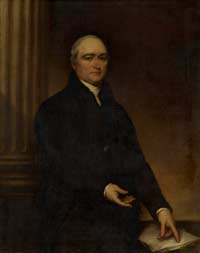 In the Stiles years, Yale depends on tuition payments for financial income and, fortunately, more applicants are available as the farmers of Connecticut prosper by providing food and goods for the colonial military. Students are freed of their obligation to serve in the Connecticut militia, an incentive to become a Yale student. Yale now has more students than Harvard, but Harvard has more financial resources.
In the Stiles years, Yale depends on tuition payments for financial income and, fortunately, more applicants are available as the farmers of Connecticut prosper by providing food and goods for the colonial military. Students are freed of their obligation to serve in the Connecticut militia, an incentive to become a Yale student. Yale now has more students than Harvard, but Harvard has more financial resources.
The Corporation (still all Congregational ministers) is attacked by Timothy Dwight who contemplates opening a rival college. Dwight charges the Corporation with elitism and mishandling the affairs of Yale. Fortunately, Stiles stays above the fray. Because the Congregational church is split into four parts: Old Lights, New Lights, Half-Way Covenant, and New Divinity, Connecticut Congregational churches lose favor with the general public. The assembly looks to a Yale that will prepare students for secular careers. The former appeal of a minister’s life as town leader is waning. Also, any hint of elitism fostered at Yale is condemned by a public now embracing a new constitution that breaks free of the English aristocratic mold.
The old battle between the assembly and Yale inherited from the Clap years, is now reignited. The assembly receives numerous petitions for action against Yale, most of which it ignores (as in the past.)
Stiles popularity is strong on and off campus and his forward plans for Yale are recognized and appreciated by the students and the assembly. In 1781, a public commencement is restarted. Stiles love of ceremony and the mood in the colonies, now with victory in war near, is most positive.
The undergraduates illuminate the college by placing candles in every window, march around the college yard, then set-off a fireworks display. The next morning, the whole college, in full gown, marches by rank to the green and the First Congregational Church. A baccalaureate service is conducted lasting until noon, when all adjourn for a public dinner. At 4 p.m. all reassemble for the granting of degrees including honorary degrees (George Washington received one), orations, and President Stiles’ address. In the evening, there is a commencement ball for the graduates in the New Haven State House. Stiles love of ceremony is shared by students and faculty and Yale commencement day becomes a highlight event for all Connecticut.
The simmering battle between Yale and the Connecticut legislature reaches a climax in 1791 when the Lower House forms a “visitorial committee” to investigate the college but the Upper House, again, refuses to go along. When Governor Huntington recommends aid to assist the college, the assembly appoints two members plus one from the Upper House to make inquiries. In September, the Corporation provides information. This exchange has Stiles most apprehensive. He fears the Corporation will be invaded by politicians. In June, 1792, the committee’s report is accepted by the legislature and an act passed “for enlarging the powers and increasing the funds to Yale College.” Stiles is overjoyed to find a recommendation to add “civilian fellows” to the Corporation (which was already planned) and Yale will receive additional funds for a new building plus an annual stipend. The 40 year battle between government and the Corporation is over with Yale the winner.
Stiles makes an excellent decision when he appoints James Hillhouse (Y 1773) as treasurer in 1782. Knowing of Harvard’s successful endowment, Yale would follow their lead. Hillhouse will be the first of many financial managers that solicit funds from alumni and others and manage the accumulated endowment for growth and income. (Hillhouse would also be elected Representative and than Senator from Connecticut serving the new federal government.)
Stiles returns to Newport for vacations during summer recesses continuing his research in many areas and reveling in the freedom and protection of liberty of the world’s greatest republic; the United States of America. Despite his personal concern that the new Constitution might turn into a kingdom, Stiles is thrilled with the success of American democracy. When the French revolution begins in 1789 he believes this a positive result encouraged by the successful government created in America.
Stiles intellectual success brought Yale material success. The student body was at 270 in 1783 and Yale’s reputation was worldwide. Donations from private sources increased. Hillhouse is successful in his investments, more books are added to the library, an appeal for more scientific instruments is productive. Upon receiving his honorary degree in 1788, President John Adams wrote, “I hold it among the most precious things ... the approbation of a university...among the foremost in America.”
Ezra Stiles defense of liberty grew as the new country formed its remarkable government. As Edmund Morgan writes, “His admiration for British constitutional monarchy had grown to a belief in democracy, just as his rational persuasion of the existence of God had grown to a faith surpassing knowledge, just as his reverence for the Puritans of New England had grown to a vision of democratic America as a new city set on a hill.” Yale is a benefactor of Stiles’ vision that remains with us today.
In May 1795, Ezra Stiles fell ill with a bilious fever and died four days later.
Clap and Stiles had many similarities in their lives before and after they became Yale president. Both were born into families of strict Calvinist parents and were the first son. Both were quickly destined to follow family tradition and to become ministers. Clap, in Scituate, MA, was educated at Harvard where he underwent a personal conversion in his freshman year. Both married soon after ordination in the Congregational church, and both fathered six children.
In the 18th Century, death was ever present and life was short. Strict Calvinists believed they were elected by God for heavenly eternal life. Their short time on earth was best served by attention to God’s will and faith in Christian redemption to merit, eternal life. Of the six children fathered by Clap, four died in the first year of life and wife, Mary Clap, died at 23 saying “bearing and burying children was hard work.”
Of the six children fathered by Stiles, all but one girl survived, but his wife Elizabeth also died young. Both Clap and Stiles, as recent widowers, were offered the Yale presidency and their commitment to Yale was extraordinary. They both perceived their service to Yale as God’s will for them and the presidency and success of Yale became their prime life’s mission.
Clap died shortly after resigning the presidency at 63 years of age, content on his death bed with the work he had done. Stiles died at age 68, still in office, and still actively striving to make Yale the world’s greatest university.
The future course of Yale as a university with studies in virtually every field of human inquiry was set by Clap and Stiles and their creation would now be completed by Timothy Dwight.
Naphtali Daggett
The Sixth Rector and Second President of Yale College
The Beginning of the American Revolution
1766 to 1777
Published January 6, 2012
The Corporation fellows refused to accept Thomas Clap’s resignation submitted in July 1766, but Clap was adamant agreeing to stay on only through commencement in September. Clap changed and improved Yale in numerous ways during his 26 years. But now the English American colonies enter perilous political times where autocratical rule is challenged at many levels of society.
From 1765, when the English parliament passed the Stamp Act, political relations between the American colonies and Great Britain began a downhill slide. Yale professor Edmund S. Morgan won the Bancroft prize in 1989 for Inventing the People. Morgan presents a convincing argument tracking the end of the doctrine of the divine right of kings that is gradually replaced by representative government. This world process took over 150 years culminating in the creation of the American Constitution.
Colonial disenchantment with English kings formed the political background at Yale and led to student animosity towards Thomas Clap. Clap’s leadership, espousing strict rules and quick punishment, was viewed as “kingly authority” now violently opposed by the students.
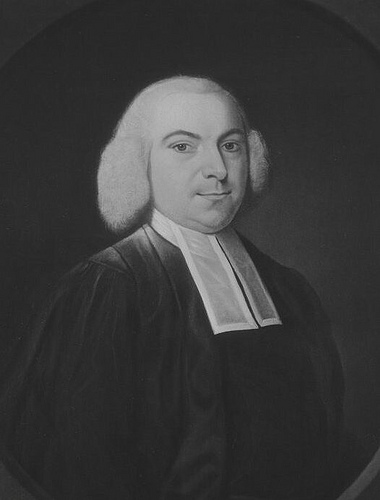 After commencement in 1766, when Clap departed, the fellows tendered the presidency to James Lockwood. After he turned the offer down, they asked Professor of Divinity, Naphtali Daggett, to be interim president. Daggett was slow to accept knowing he was a theologist, pastor, and researcher, not an administrator. However, Daggett had support among the restive students, was pacific and reasonable in temperament, and a welcome contrast to the sometimes abrasive Clap.
After commencement in 1766, when Clap departed, the fellows tendered the presidency to James Lockwood. After he turned the offer down, they asked Professor of Divinity, Naphtali Daggett, to be interim president. Daggett was slow to accept knowing he was a theologist, pastor, and researcher, not an administrator. However, Daggett had support among the restive students, was pacific and reasonable in temperament, and a welcome contrast to the sometimes abrasive Clap.
Daggett, as president pro tempore, was the first Yale graduate to be Yale president. He asked the Corporation to take responsibility for administration and fund raising. The result was propitious for Yale’s future - the exceptional tutors appointed and trained by former President Clap and new ones appointed by Daggett met the challenge with excellent scholarship and effective administration that retained and expanded the progress of the Clap years.
The success of Daggett’s Yale College was focused on excellent scholarship and the continuous addition of courses in secular areas. A new Professor of Mathematics was appointed, Nehemiah Strong (1770.) Daggett’s tutors also expanded studies in English grammar and belle-lettres. Emphasis on classical languages was slowly replaced with more dissertations and lectures in English.
Daggett left day-to-day administrative work to this accomplished group of tutors: Abraham Baldwin, Joseph Buckminster, Stephen Mitchell, Job Lane, John Lewis, John Trumbull, Timothy Dwight (later the 8th Yale president), and Joel Barlow.
The 1765 Stamp Act taxed every legal transaction in the American colonies. Flagrant refusal to pay this tax and persecution of tax collectors created an uproar throughout the northern and southern colonies. The English Parliament enacted the Stamp Act to pay off war debts incurred in Europe and North America, but the colonies were not consulted in advance nor were they represented in Parliament. In London, Benjamin Franklin lobbied on behalf of the colonies making the case that “taxation without representation” was a wrong-headed policy. In 1766, Parliament repealed the Stamp Act.
In 1767, a new government in England enacted the Townshend Acts which increased duties on English imports into the colonies. This was interpreted as taxation in disguise and colonial outrage erupted anew. The colonials refused to pay the import fees and they added a boycott of English goods which created economic harm in Great Britain. Parliament then suspended most of the Townshend Act except for a tax on tea, whereupon, the colonials refused to buy English tea.
After the Boston Tea Party in 1773, the king takes action to close the port of Boston sending troops to the city. The colonies respond by organizing local militia and “minute men” for self protection. Almost 80% of the able body men in all colonies join the call to arms. (About 20% of the populace remains staunchly loyal to the king and to England.) The hot bed of colonial resistance is Massachusetts and the largest port city in the colonies is Boston.
Tension escalates in Boston when troops arrive under General Thomas Gage who is now military governor of the colony. The original Massachusetts charter is revoked. A colonial rump assembly meets in Concord forming a Provincial Congress to provide a semblance of government in Massachusetts outside of Boston. The colony is in turmoil with towns organizing their militias and General Gage increasing his military power. More ships arrive from Europe with soldiers, marines, and munitions. The towns of Massachusetts begin stockpiling gun powder, muskets, and the rare canon in anticipation of a confrontation. Committees of Correspondence are organized between the colonies and within the towns in each colony.
In 1775, Gage has 4000 troops in Boston and ships-of-the-line in the harbor. Tension continues rising throughout the winter and, by spring, Paul Revere and other message riders are closely watching every movement of troops quartered in Boston. Nearby towns have their male inhabitants armed and ready and the outbreak of open warfare seems imminent. April 18, 1775 is the fateful day when the Boston Common is used to muster troops for an inland raid on the munitions believed stored by the “rebels” in Concord.
At 10:30 in the evening the troop assemblage on the common is observed by Revere and others and riders go forth to alert towns north of Boston of a pending British raid. Arriving at Lechmere Point at 2 a.m., 600 to 800 troops under Major John Pitcairn begin their march towards Concord to confiscate rebel cannon and other hidden munitions.
 At Lexington, the alarm is sounded at 4 a.m., “the British are coming!” Seventy men swarm from the local tavern to guard the town green with Captain John Parker as the minute man leader. Major Pitcairn, demands that the rebels disperse. Parker sees the situation hopeless and orders his men to disband and not to fire. Pitcairn yells, “Lay down your arms, Damn you!” which is followed by a single shot from the British side and the war begins. The rebels retreat and eight fall dead.
At Lexington, the alarm is sounded at 4 a.m., “the British are coming!” Seventy men swarm from the local tavern to guard the town green with Captain John Parker as the minute man leader. Major Pitcairn, demands that the rebels disperse. Parker sees the situation hopeless and orders his men to disband and not to fire. Pitcairn yells, “Lay down your arms, Damn you!” which is followed by a single shot from the British side and the war begins. The rebels retreat and eight fall dead.
The British continue towards Concord as the alerted rebels organize their militia and minutemen for defense. At Concord, munitions are hidden and cannon buried, as the revolutionaries begin their own brand of warfare. Volunteer soldiers clad in homespun, armed with hunting pieces, and eager to protect their homeland, are the heart of the rebel military force. They are eager and willing to confront a trained and uniformed professional army.
Colonel James Barrett concentrates his men on Punkatasett Hill above the Concord center. The British search the town with meager results and refresh themselves in the taverns. They set fire to the court house and a blacksmith shop. Seeing the burning houses, Colonel Barrett decides to confront the British rather than allow them to burn the town.
The rebels cross into the town while the British decide to retrace their steps back to Boston. The British troops find themselves harassed by a growing rebel army of irregulars contesting them from stone walls, forests, and camouflaged placements. The orderly battles, common in Europe between disciplined armies, give way to guerrilla warfare which becomes the common order of battle now faced by the professional soldiers.
The toll on the British raiding force is considerable. Of the 1800 troops, 73 are killed with a total of 273 casualties. On the rebel side, an estimated 3700 rebels take part, 49 lose their life and total casualties are 95. The British assessment of the fighting prowess of the colonials range from “savages and cowards” to acknowledgement that the rebels showed perseverance and bravery.
Word of Lexington/Concord spreads like wild fire throughout the colonies. In New England, militia and minute men spring into action. Thirteen Colonial assemblies support the defense of land and property. Colonial troops assemble rapidly to form the first Continental Army encircling the British in Boston.
On the Yale campus in April 1775 classes are immediately suspended when news of the Concord battle arrives. Ebenezer Huntington, a senior, asks for permission to join the gathering troops around Boston. He is denied release, but goes anyway being the first Yale student to enter the Continental Army.
On campus, a company of soldiers is quickly formed and the New Haven government is asked to supply troops as part of Connecticut’s support of Massachusetts. This request is denied since forces are believed needed to counter a British threat from the sea. An outraged Captain Benedict Arnold forms the Second Company of the Governor’s Guards, demands the keys to the city powder-house, arms his men, and marches off to Boston.
After the war ended, Powder House Day was celebrated on the New Haven green for over a hundred years with a recreation of this event. A colonial clad Arnold actor would demand the keys to the powder-house from the current New Haven mayor and then march off towards Boston.
 When new appointees Commander-in-Chief George Washington and General Charles Lee pass through New Haven on their way to take command of troops surrounding Boston on May 30th, students and townies are supportive and excited. Noah Webster (1778) reports, “In the morning they were invited to see a military company of students at Yale College perform their manual exercises. They were surprised at the precision of the students who then escorted them to the Neck Bridge. It fell to my humble lot to lead this company with music.”
When new appointees Commander-in-Chief George Washington and General Charles Lee pass through New Haven on their way to take command of troops surrounding Boston on May 30th, students and townies are supportive and excited. Noah Webster (1778) reports, “In the morning they were invited to see a military company of students at Yale College perform their manual exercises. They were surprised at the precision of the students who then escorted them to the Neck Bridge. It fell to my humble lot to lead this company with music.”
A stalemate ensues throughout the summer of 1775 as the Colonial Army fortifies the heights above Boston and British troops are reluctant to venture inland after their heavy losses in the battle of Bunker Hill.
 To break the stalemate, General Washington needs heavy cannon which he knows is available at Fort Ticonderoga on the Hudson River. Washington dispatches Henry Knox to bring the cannon across New England to the Boston lines. Knox’s artillery men construct 43 sledges and employ 80 yoke of oxen to transport the heavy cannon across the ice and snow of New England mountains and valleys. After the cannon arrive at the Boston fortifications, the strategic heights of Dorchester are seized by a surprise night attack. Now with artillery positioned above the city, the colonial threat to British troops and ships makes the city indefensible. The British decide to abandon the city.
To break the stalemate, General Washington needs heavy cannon which he knows is available at Fort Ticonderoga on the Hudson River. Washington dispatches Henry Knox to bring the cannon across New England to the Boston lines. Knox’s artillery men construct 43 sledges and employ 80 yoke of oxen to transport the heavy cannon across the ice and snow of New England mountains and valleys. After the cannon arrive at the Boston fortifications, the strategic heights of Dorchester are seized by a surprise night attack. Now with artillery positioned above the city, the colonial threat to British troops and ships makes the city indefensible. The British decide to abandon the city.
On March 27, 1776, 11,000 British sailors and soldiers and 1000 loyalist refugees depart Boston Harbor for Halifax, Nova Scotia, not New York City as Washington had believed their destination. Boston is spared flame or bombardment and the colonials claim victory. Washington’s army now numbers over 13,500 men.
Outbreak of war causes financial problems at Yale. The Connecticut assembly discontinues its financial support as the colonies organize for war. The Yale Corporation decides to close campus early in 1775 and to hold a private commencement which policy continues until 1781.
Students are dispersed with their tutors holding classes in Farmington, Glastonbury, and Wethersfield. Despite the war and disrupted studies, the high quality of students and tutors remains and expands with an improved curricula that adds history, rhetoric, and belle-lettres to classwork and an overall increase in the use of the English language in dissertations and disputes -- a change in the traditional emphasis on classic languages.
On the warfront, General Washington expects the British to occupy New York City - a strategic location which could split the colonies. Washington immediately begins relocating troops to New York beginning in March 1776 and he himself arrives in April.
The task of defending New York City from a sea attack is near impossible considering the enormity of British sea power. (The Colonials are limited to a few ships of war and many privateers - some berthed in New Haven.)
The British now make their move to attack New York City. Flotillas arrive from Nova Scotia with the former Boston army and new troops from England with mercenaries hired from the Germanic city-states. Despite odds against him, Washington concentrates troops on strategic Brooklyn Heights and occupies forts along the Hudson River and Manhattan Island.
In June 1776 the British begin to arrive on Staten Island under General Howe and from Europe under his brother, Admiral Howe. Altogether, the British army totals 32,0000 men. Washington’s forces are estimated at 19,000.
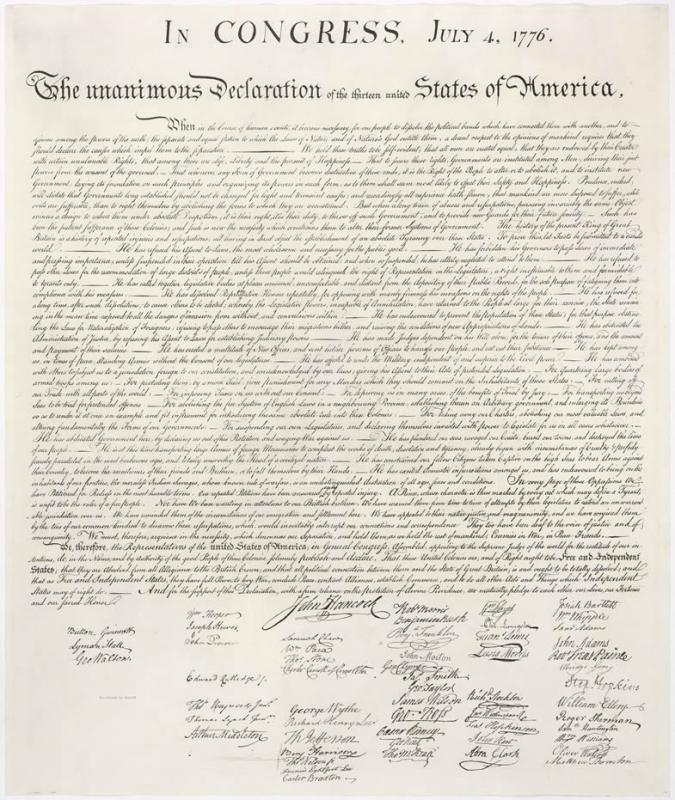 At the Continental Congress in Philadelphia in July 1776, the Declaration of Independence is announced with four Yale signers: Philip Livingston, Lewis Morris, Oliver Wolcott, and Lyman Hall.
At the Continental Congress in Philadelphia in July 1776, the Declaration of Independence is announced with four Yale signers: Philip Livingston, Lewis Morris, Oliver Wolcott, and Lyman Hall.
In August 1776, the British ferry 15,000 troops to Long Island from reserves built up in Staten Island. The battle of Brooklyn Heights follows with the colonials outflanked and outnumbered. Washington orders a remarkable nighttime retreat to Manhattan Island saving the bulk of his army from capture. Eventually, the city itself is abandoned as the colonials move north to White Plains and then to New Jersey.
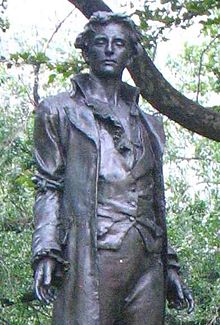 Washington’s search for intelligence on British troop movements lead him to recruit Nathan Hale (1723) a school teacher and captain in the army as a spy. Hale is quickly captured and hung. His last words are believed from the play Cato - popular in the 1700s.
Washington’s search for intelligence on British troop movements lead him to recruit Nathan Hale (1723) a school teacher and captain in the army as a spy. Hale is quickly captured and hung. His last words are believed from the play Cato - popular in the 1700s.
“How beautiful is death, when earn’d by virtue!
Who would not be that youth? What pity is it
That we can die but once, to serve our country!”
Hale’s words have been simplified in the retelling to “I only regret that I have one life to lose for my country.” Nathan Hale is the first acclaimed American hero of the Revolutionary War.
Yale students and alumni are almost totally committed to the revolutionary cause. The few Tories in the student body and alumni are ostracized. During the protracted war, over 50% of the Connecticut army officers were Yale graduates and many serve in high positions. There were six general officers in the Continental Army: Major General David Wooster, Brigadier Generals: John Scott, William Livingston, James Wadsworth, Oliver Wolcott, and Gurdon Saltonstall.
At Yale, the dispersed students become displeased with President Naphtali Daggett and petition the Corporation requesting his resignation. The fellows refuse to comply as Daggett’s major failing are his uninspiring sermons. Daggett feels his term as Yale’s president is over, so he sets his retirement for commencement in 1777.
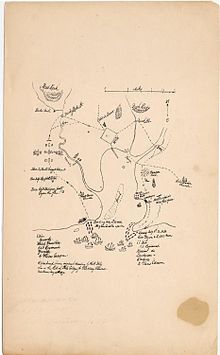 His retirement speech is most affecting, the students are won over, wishing him the best for his future. Daggett retains his original appointment as Professor of Divinity - more suiting to his desires and temperament. Ezra Stiles (1746), former Yale tutor, and a founder of the College of Rhode Island (later Brown) is elected president in 1778.
His retirement speech is most affecting, the students are won over, wishing him the best for his future. Daggett retains his original appointment as Professor of Divinity - more suiting to his desires and temperament. Ezra Stiles (1746), former Yale tutor, and a founder of the College of Rhode Island (later Brown) is elected president in 1778.
Although the war’s focus moved away from New England, punitive raids by the British navy on colonial ports become part of British war strategy. Forays up the Long Island Sound lead to attacks on Newport, Rhode Island and Connecticut towns: Norwalk/Danbury, Fairfield, and New Haven.
The attack on New Haven takes place on July 4, 1779 as the new president, Ezra Stiles, observes from a steeple top the largest fleet ever assembled on Long Island Sound drop anchor in New Haven harbor. The British land 1500 troops each in West Haven and East Haven, then join up at the New Haven green. Local militia opposition is stronger in East Haven than West Haven. The landing at Morris Point is contested with cannon on the beach and a running battle ensues as the Hessian troops make their way down the neck towards the ferry which will take them to New Haven and the center of town. The British response is to burn large homes as they fight their way down the East Haven neck.
The landing party in West Haven meets less resistance. This includes a company of Yale students and a lone sniper - an energized Naphtali Daggett hidden in bushes and firing at the British with his fowling gun. A British officer captures him and Daggett asks for his release since he is an officer of Yale College. The officer accuses him of praying against the British cause, which Daggett acknowledges. He is then forced to march at the head of the British advance guard as they approach the New Haven green. He is also pummeled and bayoneted by the soldiers which cause injuries which are believed responsible for his death two years later.
Two brothers, William and Thomas Chandler, both Yale graduates are loyalists guides for the British troops. A third Yale graduate, Edmund Fanning (1757) is the son-in-law of the commanding general of the British forces, William Tryon. Fanning is credited with saving the city from being burned. Fanning’s influence and the effective militia opposition is believed responsible for cutting the raid short. After plundering the buildings about the green and getting drunk, the soldiers sleep on their weapons and are ordered to disembark the morning of July 6, 1779.
The Clap years were filled with new programs which included more tutors and a training program. Tutors were encouraged to be creative, productive, and imaginative. They demonstrated their prowess under Daggett, administrating and teaching students in various places in multiple subjects. Eduction was foremost in tune with the times lived and they were exciting times with Enlightenment ideas overflowing into mathematics, physics, chemistry, biology, astronomy, metaphysics, philosophy, political science, medicine, military arts, English language, and, even, drama. Clap’s encouragement of secular subjects grew as Yale education moved beyond a religious concentration to emphasize using human intellectual endeavors to improve the quality of life of fellow human beings.
Significant to this change, the seeds of a university concept was born, as professors of divinity and now mathematics were added to give these subjects proper attention. Yale alumni also spawned new colleges - Elihu Wheelock founded Dartmouth in 1763, Ezra Stiles participated in the founding of Brown in 1764, Samuel Johnson was first president of King’s College (later Columbia), Jonathan Edwards was first president of Princeton, Ebenezer Fitch, first president of Williams College.
Daggett’s tenure, as president, was surprisingly positive for Yale. Despite crumbling buildings, a war that diverted energy and fortune elsewhere, Yale College demonstrated the strength of a strong institution energized by many. Yale’s organizational strength of tradition and mission was and is supported by effectively combining the individual efforts of many outstanding minds.
Thomas Clap
The Fifth Rector of Yale College and First President
1740 to 1766
Published October 28, 2011
Stephen Clap, Thomas father, was the third Clap generation political leader of Scituate, a small village near Boston. Stephen, a pillar of the church, was also an elected representative to the General Court, Massachusetts Bay Colony. His son Thomas (born June 16, 1703) would forward the family tradition of leadership by becoming a Puritan Congregational minister -- here or elsewhere.
Thomas’s earliest remembrances were family prayers - a religious imperative of his childhood. A boy, with Harvard College in his future, was exposed early to Latin and Greek to prepare him for that challenge. Diligent parents, like the Claps, used the Hornbook and the New England Primer (filled with Puritan prayers) which taught him to respond to his calling as an elected servant of God.
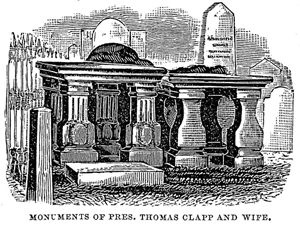 In July 1718, Stephen and his mother Temperance accompanied the fifteen year old Thomas to Harvard. After commencement exercises, they presented him to a tutor who quizzed him in Latin and Greek. Thomas made an acceptable impression and was asked to submit a Latin theme. After crossing this bar, he was accepted and Stephen paid a quarter’s tuition plus board and signed a promissory note accepting responsibility for future bills. After transcribing the college rules, Thomas’s admission was approved by Harvard President Leverett. He began his Harvard education six weeks hence.
In July 1718, Stephen and his mother Temperance accompanied the fifteen year old Thomas to Harvard. After commencement exercises, they presented him to a tutor who quizzed him in Latin and Greek. Thomas made an acceptable impression and was asked to submit a Latin theme. After crossing this bar, he was accepted and Stephen paid a quarter’s tuition plus board and signed a promissory note accepting responsibility for future bills. After transcribing the college rules, Thomas’s admission was approved by Harvard President Leverett. He began his Harvard education six weeks hence.
Boston presented Thomas an urban and intellectual challenge different from the sleepy fishing village of Scituate. As the intellectual center of Colonial America, Boston was a magical world of commerce and intellectual energy with attached temptations. Budding young adults entering Harvard were filled with restless, inquiring, sometimes uncontrolled energy, and they were bent on exercising their abilities. Warnings of sin-filled cities in biblical stories from his young years alerted Thomas Clap of dangers ahead.
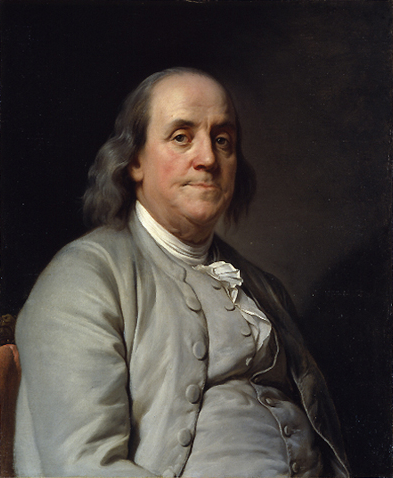 The Harvard of 1718 was described as “a training ground for delinquent saints” by Benjamin Franklin’s pseudonym, Silence Dogood, a fictitious letter writer. Franklin’s letters were regularly published in his brother’s Boston newspaper. In one scathing epistle, Silence describes Harvard as an institution for affluent families designed to instill pride and pomposity in their children.
The Harvard of 1718 was described as “a training ground for delinquent saints” by Benjamin Franklin’s pseudonym, Silence Dogood, a fictitious letter writer. Franklin’s letters were regularly published in his brother’s Boston newspaper. In one scathing epistle, Silence describes Harvard as an institution for affluent families designed to instill pride and pomposity in their children.
Students would vent excess energy by badgering tutors, raiding cellar lockers for food, placing live snakes in tutor’s rooms, breaking windows, and abusing horses. Sneaking off to Boston for hangings and carousing were other outlets for bottled energy.
Clap’s seriousness and inbred attention to moral duty kept him from these temptations. In 1719, he joined a group of students organized as a Society of Young Students -- dubbed “Praying Students” by his more adventurous classmates.
During his second year, Thomas Clap experienced a religious conversion. Under Puritan doctrine, a conversion signified spiritual communion with God and forgiveness from Adam’s sins. Thomas now had a greater understanding of his life’s mission. He was charged with doing good during his earthly life which should lead to his eternal salvation. For the next two months, Thomas experienced much concern and "Distress of Mind." Finally, divine life flowed through him cleansing his soul of impurity and depositing, in its place, a love of God. Thomas says, “(I) did seriously and solemnly give up myself to Him.” He joined a covenant with a church in Cambridge Village where he found “great delight and satisfaction in the ways of religion.”
Along with reaffirming his religious orthodoxy, Thomas found new, evolving concepts of natural philosophy and Newtonian science. Remarkable changes among intellectual thought were flowing from Enlightenment philosophers that now penetrated Harvard and the New World. Copernicus’ and Kepler’s laws of planetary motion, Galileo’s laws of falling bodies, the principles of magnetic force, all were taught at Harvard. In mathematics, Newton’s calculus (fluxions) was taught in1719, Clap’s sophomore year.
After graduation in 1722, Clap returned to Scituate to serve as apprentice minister. His first try for a position as minister on his own was at Hull, Massachusetts, but an older candidate was chosen. In 1725, three years out of Harvard, he became a candidate for an MA, and he successfully expostulated (in Latin) on the question, “Is it possible to secure remission of sins through natural reason.”
With a second Harvard degree in hand, Clap preached as a probationer in Windham, Connecticut in December 1725. He favorably impressed the congregation which led to a call to their pulpit. He was ordained minister in Windham in August 1726.
Seeking a wife with compatible moral values, he chose Mary Whiting, the young daughter of the previous minister. Mary offered a meek and quiet spirit, always pleasant and cheerful, a contrast to the often stern, Thomas Clap. The Claps produced six children in quick order. Four of them died in their first year of life. Although the Claps’ faith remained steadfast, Mary Clap succumbed at 23 years confessing that bearing and burying children was hard work.
Clap’s overriding mission was to free his parishioners from sin. To that end, he disciplined sinners by asking them to publicly confess their transgressions. He became incensed when a family turned to the Episcopal Church and he forced them out of town. It was not only moral sin that Clap sought to erase, but it was conservative Congregational doctrine that he would propagate.
Clap tended his flock meticulously. He visited every parishioner, kept written records of church proceedings, and took seriously his duty to care for all. In this effort, he was a strict disciplinarian and a terror to evil doers.
As a deliverer of sermons, Clap was more logic than emotion. Using his powerful intellect, he quickly became the County Watchdog in a consociation of churches in eastern Connecticut and he was accepted as an effective political leader.
In 1733, Clap and other conservative ministers challenged Robert Breck of Scotland, CT with Armenianism. Armenians believed and preached that a human could save oneself by doing good works. This contrasted with strict Calvinist belief that man was born with original sin and required salvation available only from God. Breck, a popular, intelligent, and young minister, drew opposition to his ordination, not only from Clap, but from far away New Haven and the President of Yale, Elisha Williams. Clap, Williams, and others forced Breck out of Eastern Connecticut.
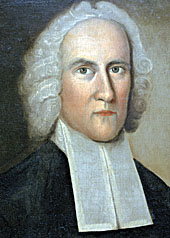 When Breck tried for a minister’s post in Springfield, MA, Clap enlisted Jonathan Edwards of Northampton, MA to join the opposition to Breck's ordination. Thus, the Breck controversy spread throughout Massachusetts and the Boston newspapers took note with, “An Affair in Springfield” headline.
When Breck tried for a minister’s post in Springfield, MA, Clap enlisted Jonathan Edwards of Northampton, MA to join the opposition to Breck's ordination. Thus, the Breck controversy spread throughout Massachusetts and the Boston newspapers took note with, “An Affair in Springfield” headline.
Clap’s involvement in Breck’s ordination battle put him in close contact with Elisha Williams who was impressed with Clap’s strict Congregational orthodoxy. Thus, when Williams resigned the Yale presidency in 1739, Clap was put him forward as the best replacement candidate. The Yale trustees, who were committed to a staunchly Congregational college, quickly offered Clap the job.
Thomas Clap saw the Yale rectorship as a fine opportunity to fulfill his life’s mission of service to mankind. Connecticut was expanding and Williams was leading a growing Yale. The Yale rector was an accepted intellectual force in New England. The college’s expanding student body and a fine president’s house awaited. The change of venue would also soften the blow of the loss of his wife.
Clap seized the opportunity to be “parentis Locus” of the students now overfilling the single Yale College building. Prior Yale rectors had little administrative power under the original college charter. Rector and tutors taught, but the trustees reserved the right to do everything else. From the very beginning of his presidency, Clap changed this by taking charge of the daily operation of the college.
Clap’s first steps were to organize the student body and to bring order to the library by classifying its books. The ad hoc operation of the school ended as Clap added new rules and statutes directing every phase of administration and student behavior. He believed that student punishment was necessary to counter a “Strong Propensity to Vice, Vanity, and Disorder.”
Taking a personal interest in the library, Clap and a tutor catalogued each of the 2500 volumes, put them in order on the shelves, and prepared three indexes as reference guides. Clap was systematic in his organization, far ahead of his time. He also added 1400 volumes to the Yale library during his tenure by persistent requests to benefactors.
Clap became totally involved with Yale. He not only taught classes, but he acted (according to current terminology) as “dean of men, dean of faculty, registrar, superintendent of building and grounds, development chair, public relations officer, librarian, alumni secretary, and chief of police.” (Tracy)
In 1745, he rewrote the College Charter which proved to be a monumental tribute to his legacy. Essentially, the new charter invested the trustees with legal authority of an Incorporate Society thus becoming a self-perpetuating organization. Only the president and fellows (titles hereafter used for rector and trustees) held the power to establish, Laws, Rules and Ordinances. In
effect, Clap became the controlling executive agent who made all major decisions. The fellows merely confirmed and advised on his actions.
 Not only did Clap radically change the legal foundation of Yale, he launched an impressive building campaign. The original single Yale College building could accommodate only 50 students with the balance finding quarters in private homes. In 1750, the foundation of Connecticut Hall, a new dormitory building on the Yale campus was laid. The new dormitory added 32 chambers and 64 studies. This alleviated off campus living, but did not completely house all the students which, in 1752, numbered 170.
Not only did Clap radically change the legal foundation of Yale, he launched an impressive building campaign. The original single Yale College building could accommodate only 50 students with the balance finding quarters in private homes. In 1750, the foundation of Connecticut Hall, a new dormitory building on the Yale campus was laid. The new dormitory added 32 chambers and 64 studies. This alleviated off campus living, but did not completely house all the students which, in 1752, numbered 170.
In 1761, Clap added a chapel which would also house books and a growing accumulation of scientific instruments. After Clap gained approval for a professor of divinity, he personally contributed land for a house for the new professor which was built by private subscription.
Yale actually graduated more students than Harvard during Clap’s tenure - over the seven years ending in 1760. Clap oversaw a meteoric growth of Yale college.
Being a Harvard graduate, Clap patterned the Yale curriculum after the Harvard he knew. Both colleges looked to England and Oxford and Cambridge for leadership in higher education. Clap considered religion as the “Great object of my fear and concern.” Although committed to religious dogma, Clap broadened Yale’s class work with a strong, secular base. He lectured, personally, on secular subjects believing that many students were destined for careers, other than the ministry. His subjects included English law, agriculture, anatomy, heraldry, and gunnery. He dramatically changed teaching patterns in mathematics and natural philosophy.
At first, Yale trailed Harvard in its presentation of mathematics and science, but after Clap became president, his continuous effort to improve Yale in every area, initiated a Golden age of mathematics and science. While previous presidents (Cutler and Williams) had introduced Newtonian physics and mathematics, Clap expanded courses in these and other secular areas. Clap quickly mandated mathematics for every class beginning in 1742. The special language of science, mathematics, began in the freshman year with arithmetic and algebra, continued in the sophomore year with geometry, and then, in the junior year, to advanced mathematics with conics and fluxions (calculus.) In 1766, a revised curricula brought mathematics to freshmen, trigonometry and algebra to sophomores, and advanced mathematics to juniors.
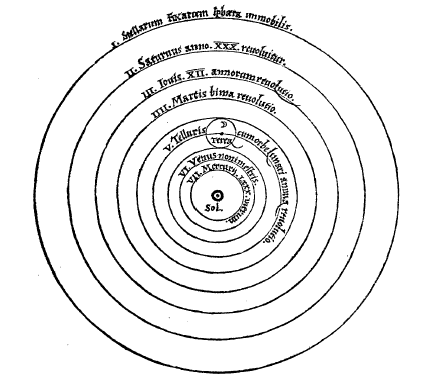 Clap introduced new texts as he upgraded the Yale natural philosophy offerings. Charles Morton’s Compendium Physicae was a textbook Clap was familiar with as a student at Harvard. Morton organized his treatise on Aristotelian principles, with updates to include the discoveries of the late 17th Century including a description of the sun centric planets. To reinforce his emphasis on mathematics, The Young Mathematician’s Guide, by John Ward, was introduced and became the Yale math text for many decades. Natural philosophy was now presented in English rather than Latin.
Clap introduced new texts as he upgraded the Yale natural philosophy offerings. Charles Morton’s Compendium Physicae was a textbook Clap was familiar with as a student at Harvard. Morton organized his treatise on Aristotelian principles, with updates to include the discoveries of the late 17th Century including a description of the sun centric planets. To reinforce his emphasis on mathematics, The Young Mathematician’s Guide, by John Ward, was introduced and became the Yale math text for many decades. Natural philosophy was now presented in English rather than Latin.
As Newtonianism flourished, many books were available explaining Newton’s theories and framed to present scientific knowledge as consistent with Puritan orthodox beliefs.
Clap earned his personal scientific credentials in astronomy, specifically, in tracking meteors and proposing a theory of earth orbiting objects. He tracked meteor sightings and submitted a paper to the Royal Society on the subject. He became a correspondent of Benjamin Franklin who sent Yale a frictional electrical machine.
Harvard and other universities rated their attention to natural philosophy by enumerating their scientific apparatus. When Clap prepared The Annals or History of Yale-College, 1700 to 1760 he itemized Yale’s apparatus (in 1763) as, “a good air pump, set of globes, telescope, small astronomical quadrant, microscope, thermometer, theodolite, and an electrical machine.” Clap also personally constructed an orrery (planetarium) - a hand operated model of orbiting planets and moons. It was seven feet in diameter and manually operated to reflect the earth’s present position. Clap’s orrery is claimed to be the first of its kind in the New World.
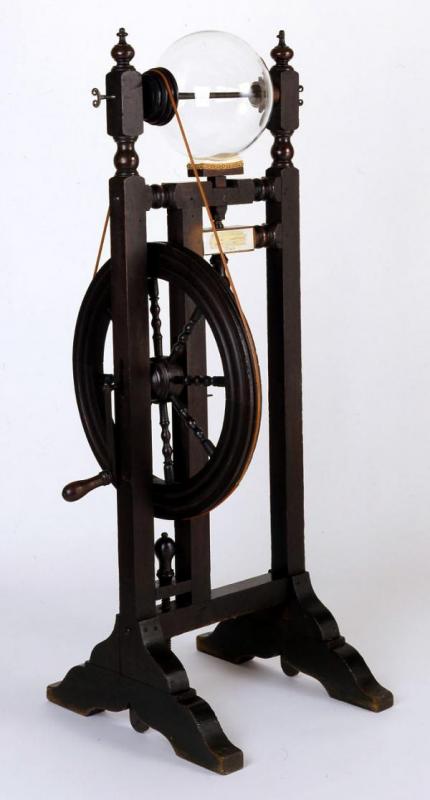 Clap appealed to friends in England for apparatus and books. His friendship with Benjamin Franklin brought the delivery of the electrical machine and his entreaty to Franklin to establish a print shop in New Haven bore fruit. Franklin was a regular correspondent and occasional contributor to Yale which earned him an honorary MA degree in 1753.
Clap appealed to friends in England for apparatus and books. His friendship with Benjamin Franklin brought the delivery of the electrical machine and his entreaty to Franklin to establish a print shop in New Haven bore fruit. Franklin was a regular correspondent and occasional contributor to Yale which earned him an honorary MA degree in 1753.
Clap understood that text and scientific apparatus were no substitute for good teachers. He created a teacher training program that emphasized natural philosophy. Many of the 28 tutors he appointed were outstanding and distinguished. Through Clap’s intense concentration, Yale became an important center of Newtonian science. Yale and Clap were the first to introduce laboratory science to the new world shaping the cultural bent of American civilization.
In the background of Clap’s changed and expanded curriculum, the Great Awakening came to New England. In 1740, George Whitefield, after impressive appearances in the Middle Atlantic Colonies, began his evangelical tour in Boston. Whitefield, with “Flaming oratory and (a) gesticulating delivery,” had the unusual ability to be heard in the open field by thousands of people. His Pied Piper personality had a profound effect on thousands that filled local churches with new faces. Whitefield added Jonathan Edwards to his entourage and was warmly welcomed by Thomas Clap when he arrived in New Haven.
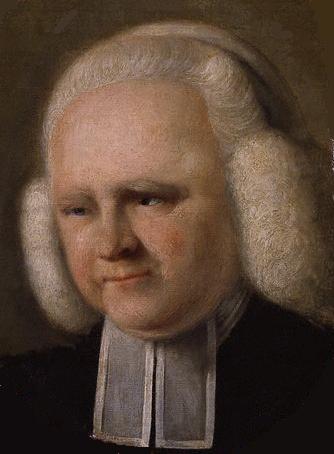 Whitefield’s first tour of New England drew praise and support from Thomas Clap as he assumed the leadership of the New Lights in Connecticut. Whitefield’s emotional delivery and great success led to copy-cat preachers who embraced the evangelical spirit and, at times, were characterized by, "a disease - a sort of madness." In New Haven, Gilbert Tenant of New Jersey and James Davenport, a great grandson of the New Haven founder, became preachers of “a Satanic seduction.” Davenport resorted to tearing off his clothes to demonstrate freedom from earthly things.
Whitefield’s first tour of New England drew praise and support from Thomas Clap as he assumed the leadership of the New Lights in Connecticut. Whitefield’s emotional delivery and great success led to copy-cat preachers who embraced the evangelical spirit and, at times, were characterized by, "a disease - a sort of madness." In New Haven, Gilbert Tenant of New Jersey and James Davenport, a great grandson of the New Haven founder, became preachers of “a Satanic seduction.” Davenport resorted to tearing off his clothes to demonstrate freedom from earthly things.
In October 1740, the Great Awakening, while bringing in new people also brought a “Spiritual shambles.” The result for the Congregational churches of Connecticut was a split into three parts First the New Lights, who enthusiastically accepted enthusiasm as a reforming element of their church. The Old Lights remained more conservative promoting a traditional Congregational Calvinistic orthodoxy. Then, as a compromise, the “Half Way Covenant” were those who believed they could find a middle road.
The Old Lights were appalled when a horde of itinerant evangelicals began filling Connecticut churches. The evangelicals were charging established ministers with improper ordination and a lack of authority to preach. At the 1741 commencement, two evangelicals roil Yale and New Haven. Center Church splits severing its close relations with Yale. As a solution, Clap proposes a university church and the calling of a professor of religion.
Clap now becomes the leader of the Old Lights as infatuation with evangelism cools. A rising interest in religion does swell most churches and the number of Anglican parishioners grows and New Haven has its first Episcopal Church close by the Yale campus.
In 1744, Whitefield plans a second tour of New England and both Harvard and Yale deny him access to their campuses. In the intervening years, evangelicals had evolved into a railing against Puritan doctrine. Nevertheless, Whitefield’s second appearance in New Haven draws thousands to the green.
In 1745, Edwards, in his commencement address, cautions against an overreaction to revivalism. The first Great Awakening subsides and sanity returns to the pulpit.
The Great Awakening, begun in 1740, saw Thomas Clap move from a fervent supporter of enthusiasm to “Pope of the Old Lights” as emotionalism and dependence on Terrible (fire and brimstone) sermons attract new believers, but now traditional Christianity returns.
Clap’s establishment of a university church enflames Benjamin Gale (Yale 1733) who staunchly believes in separation of church and state. Yale, from its inception as the Collegiate School in 1701, had appealed to the Connecticut Assembly for financial support. Now, in 1750, Yale is home to its own church. Gale sees this as contrary to separation of church and state and believes that Clap has grown too powerful.
In New Haven, the well-respected Thomas Clap engages in a pamphlet war with Benjamin Gale. (Gale is the son-in-law of Jared Eliot - a respected Yale graduate and trustee.) In 1755, Gale begins a long running avocation of added control of the college by the legislature. Clap responds with a strong defense of Yale as an independent, private institution.
Gale is “a sworn enemy of all sorts of tyranny -- civil, military and ecclesiastical.” He sees Clap as the ultimate ecclesiastical tyrant. In 1763, Gale files a memorial with the state assembly against Clap and in favor of visitation rights for a committee of assemblymen to assess the operation of Yale.
The issue of additional assembly control is put on the floor of the assembly and Clap is asked to respond in person. He articulately defends the independence of the founding fathers, arguing a precedent from the common law of the ownership of the facilities and its operation by the founders. He backs his arguments with a personal history of Yale. A conclusion that Clap draws touts the recent growth and new prestige of the present Yale College which attests to a successful administration. Clap argues that the Gale memorial is a “tissue of misrepresentations and untrue allegations.”
The assembly is persuaded by Clap and, to the dismay of Gale and other Clap antagonists, the assembly takes no action. Clap emerges at the peak of his power, proving to many that his multifaceted skills are a lasting benefit to Yale College and a credit to its independence as a private institution.
While Clap was triumphant in protecting Yale, his leadership, as viewed by his students, is in rapid decline. Thomas Clap was, indeed, educated and matured in Old Testament, orthodox doctrine that emphasized the total control and power of God as unchallenged authority. He believed, as “parentis Locus” that his word and authority was exerted to save students from eternal damnation. As their parent, his duty was to discipline and to define their lives on campus. The students see this as tyrannical behavior.
Again, in the background, political change was underway. Relations with England were disintegrating as parliament continued to act against colonial interests. By 1764, a time of incessant turmoil had impacted the Yale campus. Each senior class opposes Clap and rebels against his leadership. The decade long Gale/Clap controversy wears Clap down as his students cheer for Gale.
Now time takes its toll on an aging Thomas Clap. In 1766, rebellious students ransack the campus and threaten tutors who, for their own safety, leave campus and go home. Trustees see the student action as part of the “Spirit of the Times and the influence of others.” Clap sees a need to retire. With the tutors off campus, only Clap and Naphtali Daggett, the professor of divinity, remain to teach classes. In July 1766, Clap offers his resignation and the trustees refuse to accept it. He agrees to stay until commencement in September, delivers a positive review of his tenure, and leaves for “Sweet Retirement.” While the newspaper lauds Clap for his “Elegance and Dignity,” the students dance in the State House.
Clap’s health quickly fails and he dies in January 1767 “without a groan or a struggle,” calm and composed, ending a life of service to God and Yale.
Epilogue
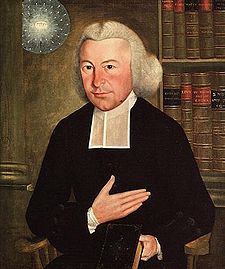 Historical reviews of Clap’s presidency seem to focus on personality without appropriate credit for his enormous achievements. Among those accomplishments are his defense of the Yale presidency which he molded and then convinced the Connecticut Assembly to ratify in an improved form of organization of trustees and president that has stood sound for hundreds of years. Clap’s Yale Corporation exists today to serve the university remarkably well. Clap’s defense of a free private university with minimal government oversight is a right established by him throughout our free society.
Historical reviews of Clap’s presidency seem to focus on personality without appropriate credit for his enormous achievements. Among those accomplishments are his defense of the Yale presidency which he molded and then convinced the Connecticut Assembly to ratify in an improved form of organization of trustees and president that has stood sound for hundreds of years. Clap’s Yale Corporation exists today to serve the university remarkably well. Clap’s defense of a free private university with minimal government oversight is a right established by him throughout our free society.
In his religious orthodoxy, Clap was Moses re-writ. Time has seen strict Calvinism lose its attraction, yet, Clap dispensed Christian forgiveness. He also softened his stance towards Anglicans by broadening religious studies at Yale to include them.
While becoming an intellectual leader of his time, he demonstrated many skills put to use for Yale. The college grew to great stature during his tenure.
Ezra Stiles, who was a student of Thomas Clap, (Yale 1746,) was ordained Congregational minister in 1749, and became a Yale tutor for six years serving under Clap. Stiles would eventually become the seventh president of Yale. These comments were published after his demise: “President Clap was possessed of strong mental powers , clear perception, and solid judgment. In mathematics and natural philosophy, he rose to sub-lime(r) heights, and became conversant in the application of this noble science to those extensive laws of nature, which regulate the most stupendous phenomena... throughout the stellary universe. He was well read in the Fathers, and had examined all the remains of the antiquities of the primitive church. He was considerably read in the common law of England and the municipal laws of his country. He had obtained such a general knowledge of ecclesiastical law that he would have honored a Doctorate in both laws. He was indefatigable in labors, both secular and scientific, for the benefit of the College. He was a calm, still, judicious, great man.”
Upon reading Ezra Stiles evaluation of Clap, Dr. Timothy Dwight remarked, “There will remain little doubt that he was the greatest man who ever sat at the head of this institution.”
Bibliography
- Puritan Protagonist; Louis Leonard Tucker, Univ. of NC 1962
- The Annals of Yale-College, 1700 to 1766; Thomas Clap, New Haven 1766
- Schools of the Prophets; Richard Warch, Yale University Press 1973
- Yale A History; Brooks Mather Kelley, Yale University Press 1974
- Annals of Yale College; From its Foundation, to the year 1831, Ebenezer Baldwin, General Books, 1838
- The Great Awakening; A History of the Revival of Religion in the Time of Edwards and Whitefield, Joseph Tracy, General Books, 1845
- Morton’s Compendium Physicae; Charles Morton, The Colonial Society of Massachusetts, Vol. 33, 1940
Elisha Williams
Fourth Rector and Second President of Yale College
1726 to 1739
Published June 9, 2011
The four year hiatus of a college without a resident leader ended with the appointment of Elisha Williams as rector. The trustees made a wise choice.
Williams’ impressive intellect emerged when he entered Harvard at 14 years of age graduating three years later (1711) as class leader and Scholar of the House. A contemporary described him as a person with “uncommon strength of memory and judgment (and a) vigorous and lively imagination.” He returned to Connecticut to study theology under his father William Williams.
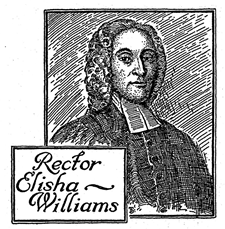 In 1716 he became a popular tutor at the Collegiate School in Wethersfield. Williams’ teaching during the split campus years was a positive contribution in a difficult time. His great popularity as tutor helped the troubled infant college maintain its educational excellence through his well received, competent instruction. Williams also became an elected member of the Connecticut Assembly, an accomplished tradesman, and a skilled lawyer and minister.
In 1716 he became a popular tutor at the Collegiate School in Wethersfield. Williams’ teaching during the split campus years was a positive contribution in a difficult time. His great popularity as tutor helped the troubled infant college maintain its educational excellence through his well received, competent instruction. Williams also became an elected member of the Connecticut Assembly, an accomplished tradesman, and a skilled lawyer and minister.
In September 1726, the four year search for a suitable president ended the leadership vacuum caused by the firing of Rector Timothy Cutler who defected to the Episcopal Church. To assure his religious orthodoxy, Williams, in the presence of the Yale trustees swore acceptance to the Saybrook Platform - the consociation of all Connecticut Congregational churches - and he consented to the rules of church discipline. Williams gave his acceptance speech in the Yale College library and then the new rector and the trustees adjourned to the impressive on campus president’s house now occupied for the first time.
The student body that Williams inherited was disorderly and under little supervision, but, at least, the college was unified and in New Haven housed in the impressive Yale College building. Williams moved quickly to resolve his first challenge - restoring student discipline, answering quickly any grievances, and enforcing college rules.
It took Williams three years to install good customs and strengthen the administrative staff. The butler (a position once held by Jonathan Edwards) had responsibility for serving breakfast (bread and beer,) afternoon meals, and helping the steward serve the main meal in commons. The butler also kept quarterly accounts of the condition of student rooms. Until a new position of monitor was established in 1727, the butler made note of student’s behavior. The Scholar of the House was responsible for, “observing and noting all detriments ... to windows, doors, study tables, (and) locks.” Breaking glass windows seemed to be a student pastime which, in one quarter, cost one rambunctious student fines of 7s.
Williams careful imposition of a few new rules and enforcement of existing rules was accepted by the students. In 1729, the class valedictorian lavishly praised Williams, “ for his kind influence and prudent government of the college.”
According to Richard Warch, author of a history of early Yale (School of the Prophets,) “By 1730, Williams supervised an active administrative hierarchy that ran the college: eleven trustees dictated Yale policy, the rector and two tutors did the teaching, one tutor acting as librarian: a steward provided the food in commons; a treasurer handled all financial accounts; the butler, scholar of the house, and monitor all performed their assigned duties. Yale College had acquired a working institutional framework.”
Elisha Williams’ excellent administrative ability built up the college’s reputation and increased its student body from an average of ten graduates per year to seventeen per year. Williams annual salary rose from 170 pounds to 300 pounds in 1730 where it remained until he retired. Annual expenditures rose from 315 pounds to 702 pounds in 1738. The annual deficit was about 100 pounds per year.
The considerable progress achieved brought financial strain and stimulated repeated requests to the General Assembly for revenue grants which were positively received. A partnership between Yale College and the colonial government benefited both. The legislature and governor helped maintain a college that served the colony and provided ministers and civil servants of high caliber. The college, through Williams, recognized its responsibility as educator to maintain an orderly environment, high quality facilities, and a first class education.
Elihu Yale died in 1721 and Jeremiah Dummer’s attempts to have Yale’s estate follow through on promises made were not successful. Another key donor- supporter was needed and, from an unexpected source, a new benefactor emerged.
George Berkeley was born in 1685 in the County of Kilkenny, Ireland of a noble family. From his early youth, he displayed a rare intellect which was well educated in local schools and, eventually, at Cambridge University. As a significant contributer to the Enlightenment, he became a polymath known for his significant philosophical theories which laid the foundation of empiricism. He also challenged Isaac Newton, learned and modified calculus becoming well versed in Newtonianism. Moving to England, he was a contemporary and colleague of Addison, Pope, and Steele. His philosophical precepts influenced David Hume, and later, Immanuel Kant. His publication - Principles of Human Knowledge (1710 & 1713) - proposed his system of philosophy which is still under debate.
 Berkeley retained a solid faith in an omnipotent God who created a wondrous, difficult to understand universe. In 1721 he became a Doctor of Divinity in the Church of Ireland (Anglican) and became Dean of Derry in 1724.
Berkeley retained a solid faith in an omnipotent God who created a wondrous, difficult to understand universe. In 1721 he became a Doctor of Divinity in the Church of Ireland (Anglican) and became Dean of Derry in 1724.
In 1725, Dean Berkeley proposed to form a college in Bermuda. To further this project, he moved to Rhode Island in 1728 and settled on a plantation where he met other New England clergymen and intellectuals. Among his associates were Samuel Johnson and Jared Eliot, both graduates and former tutors of the Collegiate School. Learning of Berkeley’s great interest in founding a college in the New World, they introduce Berkeley to Yale College and, since both were members of the Anglican church, Berkeley is impressed. The Bermuda college project founders causing Berkeley to consider alternatives. Samuel Johnson convinces Berkeley that he could fulfill his quest to further higher learning in the New World by a gift to Yale. Berkeley responds, “to be useful, I should be very glad.”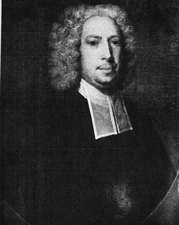
In 1732, Berkeley returns to England. Wishing to conclude his encouragement of a college in the New World and believing that Yale, “breeds the best clergymen and most learned of any college in America,” he sends the deed of Whitehall, his 96 acre estate in Rhode Island, to Samuel Johnson signed over to Yale College. At first, the trustees are skeptical not wishing to be seduced into Anglicanism, but Johnson assures them that no strings are attached.
Eliot and Johnson, despite differences in theology with the Congregational ministers who are Yale trustees, press a common interest in Yale’s future. The Berkeley gift proves a godsend to the college at a critical time.
In 1733, Berkeley follows through with a second important donation: 880 books from his English library including the works of Spencer, Shakespeare, Ben Johnson, Cowley, Milton, Butler, and Dryden. The Yale librarian now claims, “the finest library in the New World.”
In 1739, Elisha Williams resigns as rector claiming ill health and failing eyesight. Some historians see political ambition since he continues an active life including investments in iron smelting from his home in Wethersfield. He rejoins the General Assembly as speaker but his hopes to be governor never materialize.
In 1744, an anonymous pamphlet is published in Boston entitled, “The Essential Rights and Liberties of Protestants.” Williams is generally accepted as its author. In this tract he states, “As reason tells us, all are born thus naturally equal, with an equal right to their persons, so also with an equal right to their preservation.” This presages Thomas Jefferson’s words in the Declaration of Independence, “All men are created equal.”
In 1745, Williams is sent to Boston to represent Connecticut in a military expedition to Nova Scotia. This is part of King George’s War in America now a fight between England and France. Williams is made chaplain of the troops which successfully capture Louisburg from the French. In 1746, he is made colonel and plans a foray to Quebec which is never launched.
In 1749, Williams is dispatched to England to seek funds for his troops. After intense lobbying, he receives half his claim. He is accepted as a member of London’s dissenter society and testifies before the House of Commons. He is praised by Dr. Dodridge, “Colonel Williams is one of the most valuable men upon earth.”
Williams’ last major political act is to attend the Albany Congress in 1754 as a Connecticut representative. The conference, proposed by Benjamin Franklin, meets to consider a union of states (seven of the thirteen colonies are represented) to treat with the Indians. The Albany Plan of Union would create a grand council of colonies to act as an umbrella group to conduct relations with a similar combine of Indian tribes. The proposal fails as the colonies are unwilling to dilute their hard earned political powers. Historians see this as a first step to independent government in the New World.
In 1739, when Williams resigned, Yale was almost four decades old. The original trustees had gone the way of all flesh. Williams had shepherded Yale College from a vulnerable, scattered institution, whose mortality was within sight, to a sound institution with teachers, staff, donors, and students contributing to a lively institution of higher learning with growing respect.
The maturing of Yale College occurs as great advances in human knowledge percolate in the background. The era known as The Enlightenment unwrenches ancient learning principles while embracing new fields of learning. Great mental advances in philosophy, particularly natural philosophy, and associated emerging fields of science and medicine are debated in the salons and academies of Europe. Enlightenment advances filter their way to America. At Yale, Samuel Johnson introduces classes on Newtonian physics. Benjamin Franklin, electrical scientist as well as political leader, contributes to world knowledge and demonstrates American intellectual prowess.
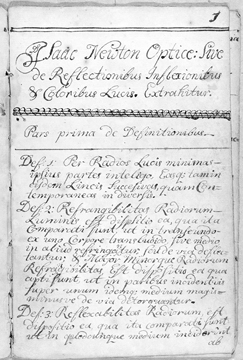 World change continues to roil Europe, their governments, and their religions. In Connecticut, Yale thinkers emerge: Jonathan Edwards, Samuel Johnson, Jared Eliot, Eliza Williams.
World change continues to roil Europe, their governments, and their religions. In Connecticut, Yale thinkers emerge: Jonathan Edwards, Samuel Johnson, Jared Eliot, Eliza Williams.
Williams dies of cancer in 1755 and is praised at his memorial service for an exemplary life of religious sincerity, gifted with learning and grace, “Fearless in the Cause of God and truth.”
An offshoot of the Age of Enlightenment is the rise of Newtonianism resulting from the impact of Isaac Newton’s voluminous writings. The acceptance of a mechanistic universe spreads afar and, less known, Isaac Newton becomes personally involved in theology and interpretation of religious thought now impacted by science and mathematics. Newton interprets newly discovered natural laws as tools and knowledge given by God to mankind.
Concerned that his work might be diverted to attack religion, Newton enlists a young clergyman, Richard Bentley, who he schools in Principia so that he can rationally explain to a lay congregation that universal gravitation demonstrates the design and order of the universe confirming God’s existence. Scientist Robert Boyle also endows lectures at the Royal Society that are filled with science-inspired piety. Newton’s and Boyle’s efforts lead to a “holy alliance” between leaders of the Anglican church and Newtonian scientists. Cambridge University becomes a spiritual base, not only for Anglicanism, but also for a new Protestant validation of religious belief.
Paralleling the enthusiasm for Newtonianism is the growth of dissenting protestantism. In England, religious toleration emerges as does the expansion of representative government.
In New Haven, Yale College’s expanded library contains many textbooks of the Enlightenment. Rector, tutors, trustees are now engulfed in a wave of thought change flowing from Europe. The challenge posed by former Rector Timothy Cutler’s apostasy is rebuffed, but the surge of new thought cannot be slowed and, with an eye to progressive education at Yale, the Age of Science, of Enlightenment, of Newtonianism, of evangelical reawakening, and representative government, is present and will dramatically influence the future of America.
.
Timothy Cutler
Third Rector and First President of Yale College
1719 to 1722
Published April 11, 2011
The decision to replace Rector Samuel Andrew and install an on campus president in New Haven was strongly pressed by Colonial Governor Gurdon Saltonstall. The magnificent new Yale College building now coalesced a dispersed student body in one place on the New Haven marketplace. Prospects for a second building were underway to construct a president’s house.
 In 1719, New Haven, the largest Connecticut Colony city, had a population shy of a thousand residence concentrated in 150 houses near the central marketplace. Plans to build a major seaport to rival Boston or New Amsterdam was dashed by a lost ship which drained hope and fortune from the Davenport city. New Haven’s fame would center on its world renowned college.
In 1719, New Haven, the largest Connecticut Colony city, had a population shy of a thousand residence concentrated in 150 houses near the central marketplace. Plans to build a major seaport to rival Boston or New Amsterdam was dashed by a lost ship which drained hope and fortune from the Davenport city. New Haven’s fame would center on its world renowned college.
In England, Jeremiah Dummer solicited Elihu Yale suggesting annual gifts to the college which was now graced with his name. Elihu was willing, but growing feeble with age. With no male heir, his daughters would inherit his enormous fortune. Dummer did extract a verbal commitment of 200 pounds a year for the rest of Elihu’s life, but only 100 pounds was forwarded to Yale. Dummer complained that, “Old gentlemen are forgetful.”
The Yale trustees decided to build a president’s house and immediately asked for support from the colonial legislature. Authority was granted for a “brief” to raise money, a Sunday collection from all Connecticut churches was directed for the new building, and a “Duty on Rhum” for two years was appropriated.
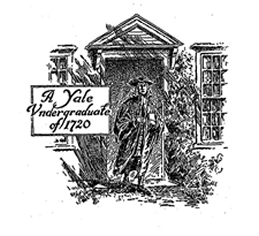 Yale student life, in the 18th century, was challenging and intense. Four continuous years were expected without relief. Commencement was held each year in September and a new class launched thereafter. The students, now housed in the great Yale College building, were dressed in academic gowns and spoke Latin most of the time. Freshmen were required to transcribe the college rules and post them in their rooms. Lights were out at nine p.m. with darkness prevailing until 4 a.m. Latin was to be spoken when in the college house. But youth is testy towards discipline, and pipes were smoked, wine was drunk, and rowdiness occasionally burst forth.
Yale student life, in the 18th century, was challenging and intense. Four continuous years were expected without relief. Commencement was held each year in September and a new class launched thereafter. The students, now housed in the great Yale College building, were dressed in academic gowns and spoke Latin most of the time. Freshmen were required to transcribe the college rules and post them in their rooms. Lights were out at nine p.m. with darkness prevailing until 4 a.m. Latin was to be spoken when in the college house. But youth is testy towards discipline, and pipes were smoked, wine was drunk, and rowdiness occasionally burst forth.
The presence of an on campus president and strict tutors was necessary to enforce the rules and assure that Latin, Greek, and Hebrew were learned well and that religious services were attended. Students memorized the weekly Sunday sermon at Center Church and they attended its three services. Time off from study, classes, prayers, and meditation was limited to visits from the family when the father checked on his son’s progress.
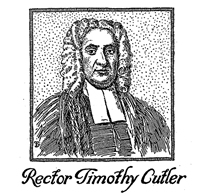 Timothy Cutler, Harvard graduate of 1701, was a rising star among the New England Congregational clergy having been dispatched to Stratford, CT to serve a congregation infected with Anglican leanings. The posting of Timothy Cutler to Stratford was the response of Congregational Church leaders to counter the surprising appearance of an Episcopal group in Stratford. A missionary named Muirhead, from the London Society for the Propagation of the Gospel in foreign Parts (S.P.G.), looked at Connecticut as fertile ground for an Episcopal church. These original Massachusetts Pilgrims had migrated to Connecticut dissatisfied with Calvinistic doctrine tending to Presbyterianism. Their independence might provide fertile ground for a return to the traditions of the mother country. By sending one of their best young ministers, the Congregational leaders attempted to offset this trend. However, the intellectual curiosity of Cutler caused him to respond favorably to the Anglican church.
Timothy Cutler, Harvard graduate of 1701, was a rising star among the New England Congregational clergy having been dispatched to Stratford, CT to serve a congregation infected with Anglican leanings. The posting of Timothy Cutler to Stratford was the response of Congregational Church leaders to counter the surprising appearance of an Episcopal group in Stratford. A missionary named Muirhead, from the London Society for the Propagation of the Gospel in foreign Parts (S.P.G.), looked at Connecticut as fertile ground for an Episcopal church. These original Massachusetts Pilgrims had migrated to Connecticut dissatisfied with Calvinistic doctrine tending to Presbyterianism. Their independence might provide fertile ground for a return to the traditions of the mother country. By sending one of their best young ministers, the Congregational leaders attempted to offset this trend. However, the intellectual curiosity of Cutler caused him to respond favorably to the Anglican church.
In 1719, Cutler accepted the trustee’s offer to move to New Haven as the new rector succeeding his father-in-law, Samuel Andrew.
The student body that Timothy Cutler inherited totaled forty youths all living in the new Yale College building. The contest over site selection had ended with a victory for New Haven. The upriver Wethersfield faction of Woodbridge and Buckingham fought one last battle when they were elected to the legislature and challenged the re-election of governor Saltonstall, but Saltonstall won handily. His win led him to take revenge on Woodbridge by having him expelled from the assembly. Chastened, the Wethersfield duo now fully supported the college in New Haven.
An attraction for Timothy Cutler and a reason for his acceptance of the Yale presidency was his friendship with former Yale tutor Samuel Johnson who introduced him to the Dummer library and its outstanding selection of Enlightenment books. Johnson led a group of vigorous young minds: Jared Eliot, John Hart, Samuel Whittlesey, James Wentmore, Jonathan Edwards, and David Browne. In addition to the writings of John Locke and Isaac Newton were religious books touting the supremacy of the Anglican church written by the great English churchmen of the time. The group of young tutors and former students relished the opportunity to join their colleagues in Europe as rationalism replaced romanticism as the motivator of human progress.
Cutler began his presidency with much enthusiasm. Jonathan Edwards, then a student said, “Cutler is extraordinarily courteous, a good spirit, the school is in excellent order, he is loved and respected by all.” While Cutler’s start was positive, the sweep of world civilization was changing and a surge of new thought was filtering into New Haven causing a challenging mixture of old and new principles. The source of Enlightenment and Anglican ideas in the Dummer books, now neatly stored in the Yale College library, was having an effect. The works of the English philosopher John Locke and the scientific theories of Isaac Newton were available, devoured by the tutors, and Timothy Cutler. Cutler effected a revolution in the Yale curriculum by lecturing on Newton and Locke with at least one report from Boston that Yale was now, “better than mother Harvard.”
Responding to Elihu Yale’s concerns about supporting “dissenters” in a colonial educational institution in the new world, Jeremiah Dummer had added the works of eminent Anglican scholars. Elihu’s motivating comment was, “If the discipline of the Church of England be most agreeable to Scripture ... there’s no better way to make men sensible of it than by giving them good learning.” Now, Elihu’s prophesy bore fruit as young Yale scholars examined Episcopal claims that their ordination as Congregational ministers was flawed.
The embracing issues of the period were religion, government, and science. The books on hand at Yale were a remarkable collection written by leaders of the Enlightenment and progressive theologians. Past philosophies and ancient reasoning were under challenge. The original trustees were slowly dying off, but the basic education they offered had hardly changed. Now this younger generation embraced Enlightenment heroes, read their books in the Yale College library, and taught their messages.
Students like Samuel Johnson and Jared Eliot had educated themselves by reading Newton and Locke. They complained that the college curriculum was emphasizing out dated precepts. The heliocentric universe of Copernicus was current; the ancient earth-centric Ptolemy system discredited, but still in the minds of the trustees.
Samuel Johnson also embraced the Episcopal Book of Common Prayer. He was fascinated by the well written prayers and orders. Johnson, now preaching in West Haven, read prayers from the Episcopal prayer book at his Congregational services and was drawing praise and additional parishioners.
Among the changes put forward by Cutler in the Yale college curriculum is a concentration on science and metaphysics in the junior and senior years. To modernize the curriculum, the old teaching in “physicks ” dating back to Abraham Pearson’s Harvard years is scraped and replaced with more recent texts. Finally, the treasure-trove of Enlightenment thought on the shelves of the Yale College library is being read and assimilated.
Another S.P.G. missionary, John Checkley appears presenting the Episcopal argument to Johnson and Cutler that the Congregational ministers were improperly ordained as only the bishops of the Roman Catholic or Anglican church could pass the Holy Spirit during ordination in a direct line tracing back to St. Peter. Checkley’s arguments are disturbing and, the group of young apprentices ask Johnson, a linguist of competence, to research Latin and Greek manuscripts to determine if Checkley is correct. After reviewing ancient manuscripts and authors on the subject of the succession of bishops, Johnson concludes that Checkley’s point is valid.
Timothy Cutler and Samuel Johnson meet with six other dissenting ministers to discuss their theological concerns and to plan a future move. Their research convinces them that the Episcopal church has the closest government to the ancient church of St. Peter and that they should take action to move Yale into the Anglican fold in the new world.
To resolve this problem, the group meets with George Pigot, an S.P.G. missionary now in Stratford. In August 1722, they ask if the mother church would support them should they declare their intention to convert Yale to Episcopal doctrine. Some acknowledge their wish to be ordained into the Episcopal church. Cutler and Johnson decide to meet with the trustees and propose that Yale College become an Episcopal school using Samuel Johnson’s research as the foundation for their proposal.
The time that Cutler chooses to meet with the trustees is September 1722 at commencement when Cutler concludes the baccalaureate service with a known Episcopal prayer, “and let all the people say, amen.” This confirms, for the trustees, that rumors are true that Arminianism has taken root with the young leaders of Yale College.
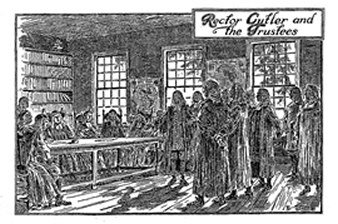 The trustees immediately demand that the seven “clear themselves from suspicion” to which the group replies in writing that Hart and Whittlesey doubt the validity of their Presbyterian ordination and that the others are persuaded of the invalidity of theirs. The shock of this declaration is felt in Boston and throughout the colonies. The trustees immediately ask the five dissenters to cease their activities on behalf of Yale and, Governor Saltonstall, hoping to resolve the matter amicably calls a special meeting of trustees and dissenters two weeks hence.
The trustees immediately demand that the seven “clear themselves from suspicion” to which the group replies in writing that Hart and Whittlesey doubt the validity of their Presbyterian ordination and that the others are persuaded of the invalidity of theirs. The shock of this declaration is felt in Boston and throughout the colonies. The trustees immediately ask the five dissenters to cease their activities on behalf of Yale and, Governor Saltonstall, hoping to resolve the matter amicably calls a special meeting of trustees and dissenters two weeks hence.
The debate takes place in the Yale library (ironically, the home of the books that convinced the ministers to rethink the validity of their ordination.) The Connecticut trustees have never questioned the circumstances of their ordination. Samuel Johnson now quotes scripture that Timothy, bishop of Ephesus and Titus bishop of Crete followed ancient rites that limited ordained bishops to ordain priests. The Episcopal church had faithfully adhered to this tenant. With no refuting arguments available, the trustees resort to invective and Saltonstall closes the meeting.
At the scheduled October 1722 trustees meeting, the trustees dismiss Cutler from his post ruing that they selected an apostate as president. The trustees also require, henceforth, that all future trustees, rectors, college officers, and tutors assent to the Confession of Faith of the Saybrook Platform - the controlling document of the Connecticut Congregational church. There is agreement that Anglicanism lies outside the limits of the Saybrook platform and Cutler, Johnson, Browne, and Wetmore renounce this policy and plan to join the church of England.
This incident shakes Yale trustees from a lethargy where they believed that preservation of reformed orthodoxy was their clear educational mission. The complacent attitude that sustained the college for its first 21 years is shattered by Enlightenment ideas and Yale’s own growth as a college with a mission to educate for “church and civil state.” The college is faithful to its goal as an educator of changing human thought and mankind’s ability to control his or her destiny were now expanding in all fields with new Enlightenment ideas.
The immediate problem for the trustees was refuting claims that Yale was a bastion of Anglicanism or Arminian thought. This was counteracted by the new requirement of a confession of faith and the dismissal of Cutler. Other objectors were welcomed back as the theological quarrel was fought in a debate elevated above its beginning of name-calling and claims of corruption. Benjamin Franklin publicizes the disagreements as “a hurly-burly in New Haven.”
Meanwhile Cutler, Johnson, and Browne head for Boston and to England for a heroes welcome. In 1722, there were no Episcopal churches in Connecticut, so they travel to Newport, RI as champions of Anglicanism. In Boston, funds are raised at King’s Chapel for their passage to England. Also underway in Boston was rapid growth of Episcopalianism that prompted the leaders of King’s Chapel to raise funds for a new church, Christ Church, to be located in north Boston.
Cutler, Johnson and Browne sail for London in November 1722 and are met, in England, with a triumphal procession. They are accepted as victors and spoils in a contest between Anglicanism and orthodox Calvinism. They also face a small pox epidemic which afflicts Cutler and takes Browne’s life.
In March 1723, Cutler and Johnson are ordained priests in the Anglican church and in May they receive honorary Doctor of Divinity degrees from Oxford and then in June similar degrees from Cambridge. The Archbishop licenses Cutler to officiate in Massachusetts. They return to Boston in July 1723. Timothy Cutler becomes the settled rector of the new Christ Church, Boston, and is inducted as rector in December 1723. He serves responsibly and successfully for the rest of his life.
Timothy Cutler, a highly intelligent and respected churchman, is also pompous and prone to controversy. While admired and respected by Jonathan Edwards, he is described as “haughty, stiff, and, morose.” Cutler lobbied many years to become an overseer of Harvard, unsuccessfully. He also sought to make Harvard an Episcopal university putting him in conflict with those opposing this view. He never returned to Connecticut.
Samuel Johnson returned with Cutler with degrees from Oxford and Cambridge now as an Anglican priest. In 1724 he opened the first Anglican Church in the colony in Stratford, CT. In 1754 he was called to the Anglican Trinity Church in New York City and, soon after, became the first president of King’s College (later Columbia University) where he was the sole instructor teaching classics and philosophy. He lobbied intensely to assure that the college would be Anglican. After his wife died of smallpox, he returned to his Stratford parish in 1763.
Yale and New Haven did not have an Anglican church for another 100 years.
The turmoil of the Cutler defection at Yale put intense pressure on the trustees to find a new president. Their first attempt was a private letter to Cotton Mather - a pillar of the Congressional Church in New England - asking him to consider the Yale presidency. Cotton declined as he hoped to eventually be president of Harvard.
There followed three more attempts, over a four year span, to find a suitable new president, all unsuccessful. During these years, the trustees set up a revolving interim plan to appoint an oversight trustee to run the college each month.
After the Mather refusal, the trustees consider Elisha Williams who was the former charismatic tutor who earned praise for his excellent work teaching at the Wethersfield location of the Collegiate School. While the trustees agree that Williams would be a capable president, lingering concerns from the contentious years of shoreline/upriver trustee fights block a unanimous offer. The same feelings prevent Timothy Woodbridge from consideration as president.
Over the next three years there follow a succession of offers and refusals. Nathaniel Williams of Boston is approached and declines. In April 1724, Eliphalet Adams of New London is considered, but his congregation balks at having him leave the parish. Edward Wigglesworth, of Harvard, declines for reasons of health. William Russell of Middletown is willing, but his parishioners refuse to release him.
The Yale commencement exercises held 1724, 1725, and 1726 are officiated by former rector Samuel Andrew.
Problems of effective leadership from the trustees catch the attention of Governor Gurdon Saltonstall who proposes an addition to the original 1701 act that established the Collegiate School. In 1723, an act is passed by the colonial legislature with five provisions: the trustees can replace a trustee who is incapacitated or inactive, it permits decisions by a simple majority vote, meetings can be called by any three trustees, the minimum trustee age is lowered from forty to thirty, and the rector of the college is granted a seat as a trustee.
In 1725, the trustees again consider Elisha Williams and this time, unanimity is reached. The trustees believe time has healed the rifts of the past. Williams is anxious to move down from his parish, the legislature helps by suspending taxation requirements for the town of Newington, and the assembly appropriates 100 pounds to support a replacement minister.
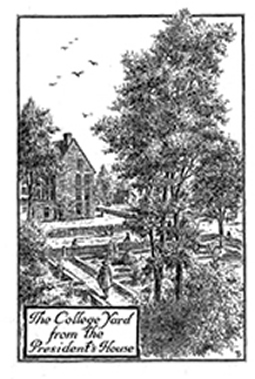 The four leaderless years following the dismissal of Timothy Cutler are most positive for Yale which demonstrates its growth as an institution. A second building is completed - the President’s House (without a president.) On campus there is a recent graduate and new tutor, Jonathan Edwards (valedictorian of the class of 1720) who is growing into an intellectual leader of Yale and the Enlightenment in the New World. The student body increases 50% to 60 students.
The four leaderless years following the dismissal of Timothy Cutler are most positive for Yale which demonstrates its growth as an institution. A second building is completed - the President’s House (without a president.) On campus there is a recent graduate and new tutor, Jonathan Edwards (valedictorian of the class of 1720) who is growing into an intellectual leader of Yale and the Enlightenment in the New World. The student body increases 50% to 60 students.
 Jonathan Edwards, not only an excellent tutor-teacher, is now deeply involved in defining reformation theology as the Great Awakening begins in New England. An evangelical wave will be influenced by the great mind of Jonathan Edwards as he grows into a philosophical theologian ranked as one of America’s greatest intellectuals.
Jonathan Edwards, not only an excellent tutor-teacher, is now deeply involved in defining reformation theology as the Great Awakening begins in New England. An evangelical wave will be influenced by the great mind of Jonathan Edwards as he grows into a philosophical theologian ranked as one of America’s greatest intellectuals.
During the years 1724 to 1726, as senior tutor, Edwards (according to recent studies at Yale), “anticipated the subsequent shape of the American culture, at once material and spiritual, piously secular and pragmatically sacred. It is due to the intersection of Edwards' colonial times with an ever-changing American 'present' that he enjoys a uniquely representative status in American thought and letters."
Stronger now by its trial of fire caused by the Cutler matter, President Elisha Williams would oversee many years of positive growth of Yale College in New Haven fulfilling John Davenport’s goal of building a great institution of higher learning.
Second Rector of The Collegiate School
The Reverend Samuel Andrew
1707 to 1719
Published January 20, 2010
The sudden death of Abraham Pierson cut short his life and plunged the new-born Collegiate School of Connecticut into a time of contest, change, and growth. The father of the institution was James Pierpont supported by founding trustees, who maintained the positive momentum of the Pierson era, at first. As time passed, factions emerged, serious issues of religious orthodoxy arose, state versus independent control was debated, and school location almost ended an ambitious attempt to create a college equal to Harvard, Cambridge, and Oxford.
After Pierson died in March 1707, the trustees quickly appointed a new rector. Their choice was Samuel Andrew who reluctantly agreed to serve as Rector pro tem. Andrew’s academic credentials were impressive. He was top of his Harvard class of 1675, made fellow of Harvard at a young age in 1679, and was briefly interim Harvard rector in 1681. While academically strong, Andrew was retiring and preferred study and theological research to administrative chores. He advised his fellow trustees that he would keep his Milford church (following Pierson’s tradition of serving as pastor while instructing the Collegiate School seniors.) Andrew thus retained the split student body with undergrads in Saybrook and seniors in remote Milford. Andrew did agree to conduct the commencement exercises as tradition required every September in Saybrook.
Saybrook, as a college home, was a compromise location halfway between New Haven and Hartford. As factions grew more contentious, trustees supporting New Haven as a home vied with stalwarts from Wethersfield representing the interior of Connecticut. Saybrook was isolated, sparsely populated, and without a town center. New students struggled to find beds to rent among the farmers of the area. Sir Fiske, the tutor responsible for educating underclassmen, concentrated on language skills in Latin, Greek, and Hebrew. His students were the brightest progeny of intelligent ministers in Connecticut. With a common thirst for learning they sought a fine education equivalent to Harvard and the best universities of Europe.
The high point of the Collegiate School year year was commencement day in September when trustees and Rector Andrew assembled to confer degrees. From an unpretentious beginning designed to avoid publicity, commencement became more like Harvard’s which was a significant time of celebration. It was a day when the top level of society, including Gurdon Saltonstall of New London, appeared in fine regalia to honor the occasion and the graduates, and to discuss current political problems of the day.
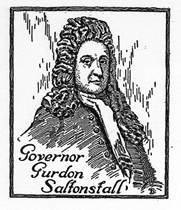 In 1708, Gurdon Saltonstall, now governor after the death of Governor Fitz-John Winthrop, faced an ongoing debate concerned with Connecticut church structure. Ministers were divided between those favoring strict Presbyterian control that affirmed doctrine mandated from above to complete independence as was preferred by most Congregational churches. The ongoing battle had induced Massachusetts Bay puritans to colonize Connecticut to free themselves from top down church control of their congregations.
In 1708, Gurdon Saltonstall, now governor after the death of Governor Fitz-John Winthrop, faced an ongoing debate concerned with Connecticut church structure. Ministers were divided between those favoring strict Presbyterian control that affirmed doctrine mandated from above to complete independence as was preferred by most Congregational churches. The ongoing battle had induced Massachusetts Bay puritans to colonize Connecticut to free themselves from top down church control of their congregations.
Saltonstall convened a Saybrook Synod to resolve this church problem. On the day after Collegiate School commencement in September 1708, a synod convened. After much debate, James Pierpont amended the draft proposed by Governor Saltonstall. The Saybrook Platform was then adopted by the synod, with governor Saltonstall’s strict principles intact but with local control retained by Pierpont’s independence provisions. The result: Connecticut churches and the Collegiate School remained independent of control from above.
The Collegiate School now faced serious financial problems. Rector Andrew was settled in Milford while students became disenchanted with their education under tutor Sir Noyes and while treasurer John Alling in New Haven was having trouble paying bills. Although an appeal for funds to the Colonial assembly met with positive interest, the government in Hartford was strapped by wars with the French and Indians. Seeing their problem as serious and fundamental to the school's survival, James Pierpont reached back to England to find donors to support the mission of the Collegiate School in Connecticut.
While many are aware of the contributions of Elihu Yale, fewer know that James Pierpont and Jeremiah Dummer, Jr. were the persons responsible for the financial survival of the Collegiate School in its infancy.
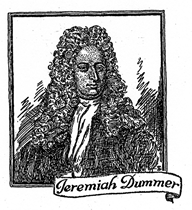
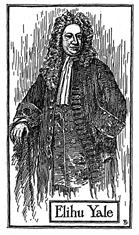 Jeremiah Dummer, Jr. was born in Newbury, MA in 1681. He graduated from Harvard in 1699, tried the ministry, but lacked a strong pulpit presence, so he emigrated to England in 1708 to engage in London politics. There, too, he was unsuccessful in establishing himself, however, his connections in Massachusetts bore fruit when he was appointed agent for the Massachusetts Bay Colony and for Harvard. Pierpont knew that Dummer had access to Elihu Yale, born in Boston in 1649, and now a successful capitalist with a fortune earned as governor of Madras in India. Among the social elite of London Elihu was now in his senior years and had no heirs. Pierpont also knew the Yale family of New Haven (part of the original Davenport settlers) which included Thomas Yale, Elihu’s cousin, and Thomas’s son David Yale (15 years old) Elihu’s second cousin. Pierpont writes Dummer suggesting that David Yale might be a proper heir to receive Elihu’s fortune. Dummer gets a positive response from Elihu who asks to see David who is then dispatched from New Haven to London. Evidently, David fails to impress Elihu and is returned to New Haven. This incident does establish a strong relation between Dummer and Elihu which begins to bear fruit when Dummer is asked by Pierpont to solicit books as donations for the Collegiate School library.
Jeremiah Dummer, Jr. was born in Newbury, MA in 1681. He graduated from Harvard in 1699, tried the ministry, but lacked a strong pulpit presence, so he emigrated to England in 1708 to engage in London politics. There, too, he was unsuccessful in establishing himself, however, his connections in Massachusetts bore fruit when he was appointed agent for the Massachusetts Bay Colony and for Harvard. Pierpont knew that Dummer had access to Elihu Yale, born in Boston in 1649, and now a successful capitalist with a fortune earned as governor of Madras in India. Among the social elite of London Elihu was now in his senior years and had no heirs. Pierpont also knew the Yale family of New Haven (part of the original Davenport settlers) which included Thomas Yale, Elihu’s cousin, and Thomas’s son David Yale (15 years old) Elihu’s second cousin. Pierpont writes Dummer suggesting that David Yale might be a proper heir to receive Elihu’s fortune. Dummer gets a positive response from Elihu who asks to see David who is then dispatched from New Haven to London. Evidently, David fails to impress Elihu and is returned to New Haven. This incident does establish a strong relation between Dummer and Elihu which begins to bear fruit when Dummer is asked by Pierpont to solicit books as donations for the Collegiate School library.
In 1712, Pierpont really gets Dummer’s attention when Harvard replaces Dummer as its agent. Dummer now receives a formal appointment as first Colony Agent of Connecticut and he uses his wide range of extraordinary contacts to solicit books for the Collegiate School. His donors include Elihu Yale, Dr. Salmon, Sir Richard Blackmoore, Sir John Davie, and Sir Isaac Newton.
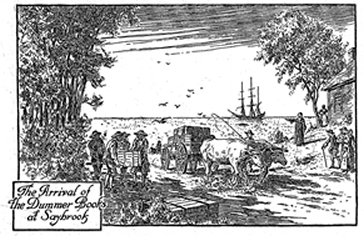 By 1714, nine large boxes of books are assembled in London and shipped to the Collegiate School in Saybrook. The works are extensive, including famous English authors and scientists: Boyle, Locke, Newton, Halley, Raleigh, Steele, Chaucer, Milton, and Bacon. Sir Isaac Newton included both Prinicipia and Optics taking a personal interest in the Collegiate School.
By 1714, nine large boxes of books are assembled in London and shipped to the Collegiate School in Saybrook. The works are extensive, including famous English authors and scientists: Boyle, Locke, Newton, Halley, Raleigh, Steele, Chaucer, Milton, and Bacon. Sir Isaac Newton included both Prinicipia and Optics taking a personal interest in the Collegiate School.
Unfortunately, James Pierpont dies just as this remarkable collection of books arrive in the sleepy village of Saybrook. The receipt of this extraordinary library gives the Collegiate School, “A new start in life.”
The death of James Pierpont and the prior death of Thomas Buckingham of Saybrook continues the winnowing of the original trustees now divided into factions favoring either Wethersfield, Saybrook, or New Haven as a permanent college home. Building a proper library for the college’s large book collection is clearly a necessity. The new library is one of the finest in the colonies. The trustees ask the colonial assembly to appropriate funds for a new building but the question now is, “Where will the college library be built? “
The Collegiate School trustees are sharply divided on the location. Timothy Woodbridge, Thomas Buckingham of Hartford, and Samuel Mather of Windsor favor Wethersfield; James and Moses Noyce favor Saybrook; Samuel Andrew, Samuel Russell, Joseph Webb, John Davenport, and Thomas Ruggles favor New Haven.
A resolution granting 500 pounds is passed by the upper assembly, but is stalled in the lower assembly by Wethersfield supporters pending a Collegiate School trustees’ majority vote on where to build. The trustees opt for a fund raising competition to decide the matter. New Haven, thanks to an energetic John Davenport (grandson of John Davenport, founder of New Haven,) has replaced Pierpont as leader of the New Haven forces. He plans a college building adjacent to the New Haven green and close to Center Church.
In 1716, the Noyces of Saybrook are won over and a majority of trustees vote seven to two for a New Haven building. The Wethersfield opponents boycott the vote. At this time, 13 students are in New Haven, 14 in Wethersfield, and 3 in Saybrook.
New Haven supporters purchase the “Coster lot,” abutting the green at Chapel and College Streets for 26 pounds from Center Church. The church had received this lot from the widow Coster now deceased. Using New Haven pledges, building begins on a proper “college building” on what is now the Old Campus.
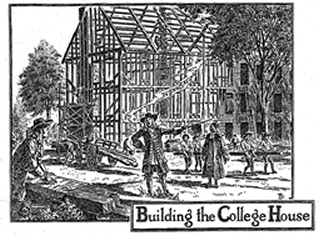 In 1717, the assembly meets in New Haven and the matter of an appropriation for a college building resurfaces on the assembly’s agenda. The delegates arrive as the framework of the “College House” is erected. Attempts by some assemblymen to avoid any debate of college site selection is averted as Governor Gurdon Saltonstall is clearly in control of the upper house and he asks for a deciding vote. The Wethersfield supporters continue to argue for postponement and they marshall the support of many lower house members, however, the final vote is unanimous in the upper house and 36 to 30 in the lower house as the motion is passed.
In 1717, the assembly meets in New Haven and the matter of an appropriation for a college building resurfaces on the assembly’s agenda. The delegates arrive as the framework of the “College House” is erected. Attempts by some assemblymen to avoid any debate of college site selection is averted as Governor Gurdon Saltonstall is clearly in control of the upper house and he asks for a deciding vote. The Wethersfield supporters continue to argue for postponement and they marshall the support of many lower house members, however, the final vote is unanimous in the upper house and 36 to 30 in the lower house as the motion is passed.
Despite the assembly’s grant, money is still needed and now Jeremiah Dummer again approaches Elihu Yale and so does Cotton Mather who has fallen out with Harvard. This former Harvard leader now strongly supports the Collegiate School. Cotton writes an effusive letter to Governor Yale pleading for help for the “infant College at Connecticut” suggesting that an appropriate gift will find a new building “baptized with his name.” Dummer, receives a copy and redoubles his effort to convince Elihu to comply. Dummer succeeds and Elihu donates 562 pounds worth of goods that are shipped to Boston, to be sold there, and the proceeds to be sent to the Collegiate School. This would be the largest donation to the college for 100 years.
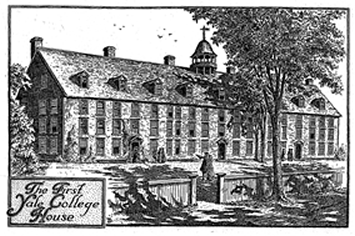 The first Yale College House was dedicated at commencement in September 1718. This most grand occasion celebrates the completion of a huge blue painted building on the green. The building cited at the corner of Chapel and College Streets was 22 feet wide, 165 feet long, and three stories high. It contained 50 “studies in convenient chambers,” a second floor library, a high ceilinged large room with two fireplaces for dining, meetings, and worship. Governor Gurdon Saltonstall conducts the dedication. The Saluting Orator is John Davenport who expresses the thanks of the trustees, “To Almighty God and to Mr. Yale under Him for so public a favor and so great a regard for our languishing school.”
The first Yale College House was dedicated at commencement in September 1718. This most grand occasion celebrates the completion of a huge blue painted building on the green. The building cited at the corner of Chapel and College Streets was 22 feet wide, 165 feet long, and three stories high. It contained 50 “studies in convenient chambers,” a second floor library, a high ceilinged large room with two fireplaces for dining, meetings, and worship. Governor Gurdon Saltonstall conducts the dedication. The Saluting Orator is John Davenport who expresses the thanks of the trustees, “To Almighty God and to Mr. Yale under Him for so public a favor and so great a regard for our languishing school.”
Unfortunately, Woodbridge and Buckingham, the Wethersfield holdouts, still remain opposed to New Haven. They launch two more battles before Yale College and New Haven are firmly bonded.
The Dummer books lodged in Saybrook become the focus of a legal battle resolved by a Colonial assembly order to release them from their Saybrook home. A court order is prepared and a sheriff and men dispatched from Hartford to release the books from Saybrook bondage and to truck them by ox cart to the new Yale College building in New Haven. Buckingham refused to release them until so demanded by sheriff and men. Saybrook’s citizens then rebel, steal books, unhitch the oxen teams, and burn bridges to prevent their transfer to New Haven. About 200 books are lost, but, eventually, 1000 volumes reach New Haven and Saybrook returns to its sleepy traditions.
The Wethersfield students are ordered to report to classes at Yale College in New Haven. They obey but arrive disgruntled and rebellious. They are determined to prove that their schooling was better up river than in New Haven. Parents appear to claim poor teaching and poor facilities. It was now 1718 and replaying the controversies of the past are clearly inappropriate for this growing institution. Rector Samuel Andrew finally enters the discussions and the trustees conclude that a resident Rector is critical for the survival of the newly invigorated Yale College.
Rector Andrew reaffirms his original intention to serve “pro tem.” The trustees decide to seek a new Rector for the future and continued growth of Yale College. They choose The Reverend Timothy Cutler, 36 years old, pastor of the Stratford Congregational Church, and Samuel Andrew’s son-in-law.
Notables of the Andrew years
While the Collegiate School experienced a tumultuous period under Rector Andrew, students continued to graduate each year and three notable scholars contributed greatly to their generation in service to colonial Connecticut and the New World.
Elisha Williams graduated from Harvard in 1711 and became tutor of the Collegiate School in Wethersfield in 1716. He educated undergrads and some seniors at the Williams’ farmhouse in an “intellectually charged atmosphere.” Williams energy and charisma contrasted with the unpopular Noyce who was serving as tutor in Saybrook.
Williams next studied law and was elected member of the Connecticut assembly. In 1745, he served as Chaplain and Colonel of Militia in an expedition to Cape Breton, Nova Scotia. He was appointed Judge of the Superior Court in Connecticut in his later years.
Elisha Williams became the 4th Rector of Yale College in 1726. His presidency will be discussed in detail in blog 5 later this year.
Samuel Johnson, born in Guilford, CT in 1696, graduated from the Collegiate School in 1716. He was fascinated by Sir Isaac Newton’s Principia and challenged himself to learn calculus and the theory of gravitation. Newton’s books were among the treasures of the enhanced library now available to Yale scholars who self educated themselves due to lax oversight, poor teaching, and a scattered student body.
The bright and inquisitive Johnson sought ordination in the Anglican Church in England, then returned to Stratford, CT to form the first Colonial Anglican church. In 1754 he was chosen as first president of King’s College (later Columbia University) where he was the sole instructor teaching classics and philosophy. After his wife died of smallpox, he returned to Stratford in 1763.
Jonathan Edwards is acclaimed as a leading intellectual, theologian, and philosopher whose writings, even now, are perused and studied as among the world’s greatest theological philosophical commentaries. His time was the midst of The Enlightenment when he immersed himself in the works of Locke and Newton. He saw the laws of nature discovered by Isaac Newton as derived from God and argued that they were demonstrations of God’s wisdom and care.
After graduation from the newly named Yale College in 1720 as valedictorian and head of class, he remained in New Haven to become “pillar tutor” for four years. He left New Haven in 1727 to be ordained in Northhampton, MA then a center of religious revival. During the Great Awakening which saw waves of evangelism sweep through New England and the colonies, Jonathan Edwards was at the center, studying thirteen hours a day, writing continuously, and championing the rights of Indians and women.
After a falling out with his congregation in Northhampton in his later years, he became pastor in Stockbridge, MA and then accepted the presidency of the College of New Jersey (later Princeton) in 1758. He died after a small pox inoculation while advocating this new treatment for the deadly scourge afflicting the colonies at this time.
Edwards progeny continued his good work in the ministry and education. Among his large family tree are many ministers, professors, and statesmen include Aaron Burr and two Timothy Dwights.
The First President (Rector) of Yale (The Collegiate School)
Abraham Pierson, Jr.
1701 to 1707
Published September 15, 2010
Abraham Pierson, Sr., a Cambridge graduate, immigrated to Boston in 1639 settling in Lynn, Mass. In 1641, a son, Abraham, Jr. was born the same year the Pierson family and sixteen others moved to Long Island to found the town of Southampton. In 1644, Pierson and family moved to Branford, CT, then part of the New Haven Colony led by John Davenport. His departure from Southampton came after the village elders chose to become part of the Connecticut Colony rather than stay with Davenport and the New Haven Colony.
In 1667, Pierson, Sr. split with Davenport on the critical issue of church governance. Seeking more control of his future, Pierson moved to New Ark, New Jersey helping to found this town. The senior Pierson, a conservative churchman and strong leader, served his congregation well until his death in 1678. His extensive library of 400 books eventually was inherited by his son, Abraham Pierson, Jr.
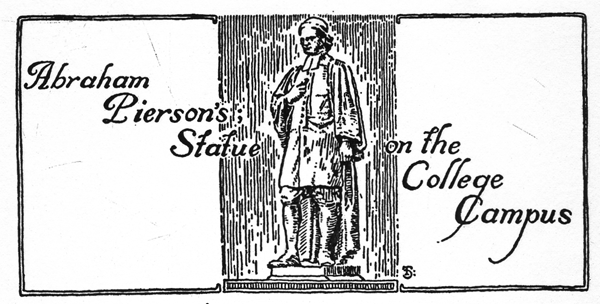 When Pierson, Jr. entered Harvard in 1664, he was one of five undergraduates in the class of 1668. After graduation, he joined his father and family in Newark to be ordained a minister and to become assistant to his father at the First Congregational Church. When his father died, he succeeded him as pastor. In 1691, the Church elders opted for a strict form of Presbyterianism prompting Pierson to move back to Connecticut to become pastor of the First Congregational Church of Greenwich. In 1694, he was called to the Killingworth Congregational Church. He soon joined other leading ministers in planning the Collegiate School, a vision of John Davenport.
When Pierson, Jr. entered Harvard in 1664, he was one of five undergraduates in the class of 1668. After graduation, he joined his father and family in Newark to be ordained a minister and to become assistant to his father at the First Congregational Church. When his father died, he succeeded him as pastor. In 1691, the Church elders opted for a strict form of Presbyterianism prompting Pierson to move back to Connecticut to become pastor of the First Congregational Church of Greenwich. In 1694, he was called to the Killingworth Congregational Church. He soon joined other leading ministers in planning the Collegiate School, a vision of John Davenport.
After their petition for “Liberty to erect a Collegiate School” passed the Connecticut General Assembly in New Haven in October 1701, Pierson and other trustees of the Collegiate School held an organizational meeting in Saybrook in November 1701 to draw up rules and operating plans for the new college. The trustees decided on a single rector as college head first offering the position to Israel Chauncy, son of the Harvard president. Israel declined and the offer was then placed before Abraham Pierson, Jr. who accepted. Since the Rector was to receive no pay, Pierson advised the trustees that he would remain pastor of the Killingworth church.
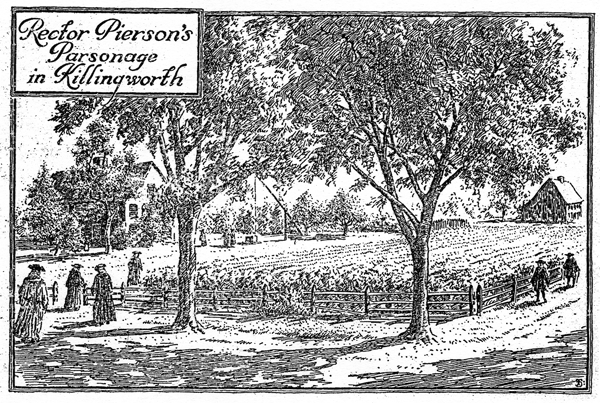 Political concerns raged for many years about the location of the new college. Trustees and other supporters formed blocs arguing in favor of placing the college in New Haven or in Hartford. When the Colony of Connecticut received its Royal charter in 1662, New London became the compromise temporary capitol. The trustees employed this precedent to select Saybrook as the compromise home for the new college. The location appeased the shoreline proponents and the up river bloc. However, the reality of Abraham Pierson’s life was his large family – a wife and nine children -- and obligations to the Killingworth Church which provided him with a large home, wood for his fireplace, and an orchard to grow apple trees. He informed his fellow trustees and his church elders that he would teach college classes in his Killingworth parsonage and also remain pastor.
Political concerns raged for many years about the location of the new college. Trustees and other supporters formed blocs arguing in favor of placing the college in New Haven or in Hartford. When the Colony of Connecticut received its Royal charter in 1662, New London became the compromise temporary capitol. The trustees employed this precedent to select Saybrook as the compromise home for the new college. The location appeased the shoreline proponents and the up river bloc. However, the reality of Abraham Pierson’s life was his large family – a wife and nine children -- and obligations to the Killingworth Church which provided him with a large home, wood for his fireplace, and an orchard to grow apple trees. He informed his fellow trustees and his church elders that he would teach college classes in his Killingworth parsonage and also remain pastor.
The trustees agreed and it now became Abraham Pierson’s challenge to bring the Collegiate School to reality. Now also appears the true strength behind the creation of the Collegiate School – the ten trustees and founders who brought vital support to the institution that became Yale University.
The first student to present himself to Abraham Pierson and to pay 30 shillings for tuition was Jacob Heminway of East Haven. The affluent Heminway family were parishioners of trustee James Pierpont, pastor of Center Church in New Haven. Jacob began his freshman year in March 1702 boarding with the Pierson household in Killingworth.
Pierson, followed the Harvard model by beginning each day early with morning prayers and appointed scriptures. Classroom work began at 6:30 a.m. with Latin recitations, or Greek readings. Breakfast was a family affair at 7 a.m. Morning classwork continued with Latin and Greek grammar and elementary Hebrew. Logic was studied from a Latin manual. The main meal of the day was at noon, a boiled meat stew with vegetables and cider and beer to drink.
Pierson’s study was his classroom - with his 400 inherited and donated books lining the walls. Afternoon classes included reading Latin treatises on metaphysics, rudimentary mathematics, and physics. Pierson’s strong interest in new scientific thought now sweeping the continent encourage his to prepare his text book describing natural philosophy and applications of a new mathematical approaches to the subject.
As the student body increased, twice a week there were disputations in Latin and exercises in rhetoric and theology for advanced classes. Most oral recitation was in Latin – the universal language of the intelligentsia during this period.
Mid afternoon was time for recreation – fishing and crabbing in this attractive shorefront community. In the late afternoon, early evening prayers were said, a light supper was served, and lights went out at 9 p.m.
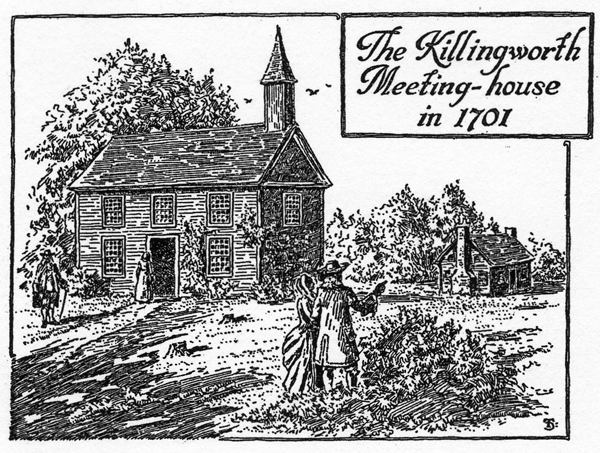 On Sundays, Abraham Pierson delivered sermons at two church services. Students attended and were challenged to repeat the sermon the next school day.
On Sundays, Abraham Pierson delivered sermons at two church services. Students attended and were challenged to repeat the sermon the next school day.
Jacob Heminway was “solus the whole college” until joined by Nathaniel Chauncy during the summer of 1702. Pierson’s reputation as a fine scholar and compelling teacher expanded. Other students appeared who were Harvard BA alumni now seeking a master’s degree. These new students saw the advantage of advanced college study in Connecticut close to home rather than make the arduous trip up the Boston Post Road to Cambridge.
On September 16, 1702, the first Collegiate School commencement took place in Saybrook, CT at the large home of trustee Thomas Buckingham. Five students, who earned their BA at Harvard were granted a master’s degree: Rev. Samuel Treat, Joseph Coit, James Fitch, Joseph Moss, and Nathanial Chauncy.
The ceremony was purposely low key with formalities kept to a minimum in keeping with the wishes of the trustees.
Interest in the new college grew as Jacob Heminway continued his second year beginning in October with added classmates: John Hart (Cambridge, MA), Samuel Russel (Branford, CT), John Andrew (Milford, CT), and Phineas Fiske (Milford, CT)
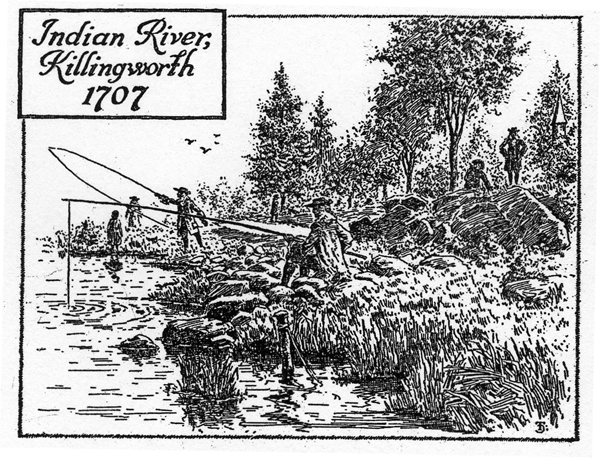 By 1703, the third year, 15 to 20 youths were studying in Killingworth. Most were sons or relatives of the trustees who provided crucial networking resources to build a positive reputation for the Collegiate School. The school’s reputation spread beyond Connecticut with a new student from Martha’s Vineyard and two from Northhampton, MA.
By 1703, the third year, 15 to 20 youths were studying in Killingworth. Most were sons or relatives of the trustees who provided crucial networking resources to build a positive reputation for the Collegiate School. The school’s reputation spread beyond Connecticut with a new student from Martha’s Vineyard and two from Northhampton, MA.
Pierson built his reputation as a strong leader, a rare scholar, and an academic pioneer. To help Pierson, tutors were hired: John Hart and Phineas Fiske, who were recent graduates.
A conflict grew as the parishioners of the Killingworth church objected to the diversion of Pierson’s pastoral mission by his expanding commitments to the college. As head of the Collegiate School he had administrative and teaching obligations on top of family duties and the hosting of students. Abraham Pierson was pressed hard from various directions. He was a most accomplished gentlemen, scholar, and man of God torn by the demands of the multiple positions of pastor and college head.
According to trustee Buckingham, “the college glorified and flourished under its first rector who displayed a pattern of piety, was a man of modest behavior, of solid learning and, sound principle.” A parishioners described him as an, “Exceedingly pious good man and an excellent preacher. He was a very kind, charitable man towards the poor and indigent.”
The tensions of his multiple commitments brought Abraham Pierson to an untimely death on March 4, 1707 at the age of 61. The Collegiate School would be plunged into a time of growth and distractive organizational problems. Yet, Abraham Pierson, Jr. had blazed a trail to success for the Collegiate School.
The impact of a college education can be measured by reference to the future lives of its graduates. By this test, there were two notable standouts from the Pierson era:
Jacob Heminway BA1704
The Collegiate School’s first student who graduated after two and half years of schooling with a BA degree. He quickly offered a new church congregation in East Haven, CT after graduation. He became a popular pastor who served until his death in 1754. The Old Stone Church still thrives and now contains a portrait commissioned in 1936 by an artist from composites of Heminway relatives. Jacob’s brother Abraham is a direct ancestor of Ernest Hemingway. Ernest’s granddaughter recalled in her memoirs, “Grandfather was rather proud of his descent from Jacob Heminway.”
Jared Eliot BA1706
An early graduate of the Collegiate School whose diverse adult life included the ministery, farming, medical practice, animal husbandry, and iron making. Jared became a leader during the pre-revolutionary time in New England. He published treatises on agricultural experiments and methods which were distributed widely advancing a scienctific approach to agriculture.
The Collegiate School and Isaac Newton
Isaac Newton, born in England in 1642 and Abraham Pierson, Jr., born in Lynn, Mass in 1641 were contemporaries although an ocean apart. Both lived productive lives during the heart of the Age of Reason. When Pierson was at Harvard from 1664 to 1668, Newton began publishing extensively from his decades of secret writings finally exposing his brilliant analysis of the natural world to an expanding and eager community of fellow scientists. Newton sought to explain in words and with mathematical tools the workings of nature. He probed and constructed theories addressing the fundamentals of light, the solar system, and optics. Mathematics, as a field of study, was then a new and controversial subject.
The Royal Society was formed in London in 1662 with intellectuals, mostly admirers of Francis Bacon, probing the natural world. Robert Hooke, an advocate of “Experimental Philosophy” led regular gatherings of like minded intellectuals in London who discussed and debated theories which at times, drew the wrath of churchmen and other intellectuals focused more on ancient learning.
The Royal Society began distributing a news sheet in 1665 called Philosophical Transactions. This was the first “journal” that established a tradition of scientific publications with world wide distribution to advance and promote important scientific discoveries. Isaac Newton inhaled its contents and was drawn out of his shell to be published. It is also quite likely that, in the early 1700s, the Collegiate School would be a recipient of this publication of the Royal Society. At Harvard, Abraham Pierson had kept class notes (now in the Beineike Library) of the evolving fields of mathematics, astronomy, chemistry, and the theoretical world of physics.
Pierson composed a manuscript covering the natural world of his day which historian Edwin Oviatt described as “remain(ing) the College text book on “Physics” for many years.” In later years, Newton furnished the Collegiate School with his latest publications.
A College is Formed
We relish the belief that we live in a most interesting time. But, the Pilgrims of Connecticut in the 17th Century surely excel us in personal challenges faced and challenges met.
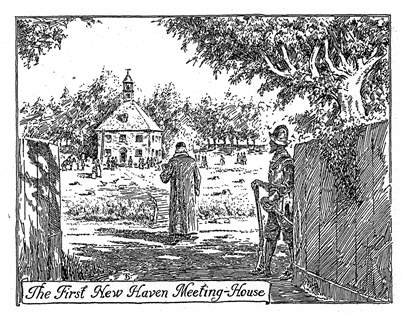 Historians designate the mid 17th Century as the Age of Reason -- an era when secular philosophers appropriated leadership from a post dark age theological dominance of our western civilized world. Education was expanding as the number of universities in Europe grew from 40 to 150. Waves of intelligent discussion wafted among the intelligencia focused on government form, church doctrine, the workings of the human mind, and the exploration of nature. Leading minds inflaming these discussions were Rene Descartes, Baruch Spinoza, John Locke, Isaac Newton, and Gottfried Leibnitz among many others.
Historians designate the mid 17th Century as the Age of Reason -- an era when secular philosophers appropriated leadership from a post dark age theological dominance of our western civilized world. Education was expanding as the number of universities in Europe grew from 40 to 150. Waves of intelligent discussion wafted among the intelligencia focused on government form, church doctrine, the workings of the human mind, and the exploration of nature. Leading minds inflaming these discussions were Rene Descartes, Baruch Spinoza, John Locke, Isaac Newton, and Gottfried Leibnitz among many others.
Connecticut became a Royal Colony in 1662, much to the dismay of John Davenport who had founded New Haven Colony on the banks of the Quinnipiac River in 1638. His vision of a prosperous church-state harmoniously thriving on a nine square center city plan was floundering. When New Haven Colony was forced to join the larger Connecticut Colony, Davenport, now an old man, returned to Boston in 1669. Hartford was now capitol of Connecticut. His vision of a college in New Haven was still unfulfilled, however, Davenport’s legacy to Connecticut was momentous and remains with us today.
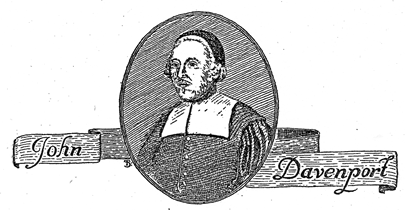 Davenport’s town plan with a central green dominated by a Congregational church - the New Haven model - was replicated along the Long Island shoreline and up the Connecticut River. Puritan pioneers left the Bay Colony or emigrated from England to find fortune and salvation in the new world in the New England towns. Connecticut towns duplicated Davenport’s church-state model supplying both moral guidelines and local government for the new settlers -- and a handsome central green that is still our New England heritage.
Davenport’s town plan with a central green dominated by a Congregational church - the New Haven model - was replicated along the Long Island shoreline and up the Connecticut River. Puritan pioneers left the Bay Colony or emigrated from England to find fortune and salvation in the new world in the New England towns. Connecticut towns duplicated Davenport’s church-state model supplying both moral guidelines and local government for the new settlers -- and a handsome central green that is still our New England heritage.
The new, royally chartered Connecticut Colony mandated free education for youth – something that Massachusetts supported but did not implement. To meet New Haven’s need for education, John Davenport and the legacy of Edward Hopkins, a close friend and wealthy merchant, formed the Hopkins Grammar School in 1641. Davenport and Hopkins also began planning for a “collegiate school” in New Haven. So the nexus for Yale University came from John Davenport’s ambitious goals although age and circumstance short circuited his personal fulfillment of this dream.
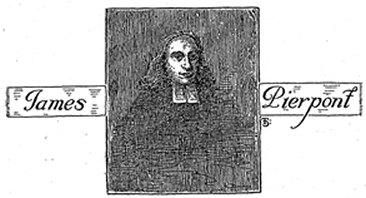 James Pierpont graduated from Harvard College in 1681. He was called to New Haven in 1685 to John Davenport’s Center Church on the New Haven green. Pierpont boarded with the widow of John Davenport and fell in love and married Abigail, Davenport’s granddaughter. In 1689, Pierpont purchased 100 books previously owned by John Davenport as the foundation of a library for a new college. Pierpont now clearly saw his destiny as inheritor of Davenport’s dream of a college for Connecticut and for New Haven.
James Pierpont graduated from Harvard College in 1681. He was called to New Haven in 1685 to John Davenport’s Center Church on the New Haven green. Pierpont boarded with the widow of John Davenport and fell in love and married Abigail, Davenport’s granddaughter. In 1689, Pierpont purchased 100 books previously owned by John Davenport as the foundation of a library for a new college. Pierpont now clearly saw his destiny as inheritor of Davenport’s dream of a college for Connecticut and for New Haven.
We speculate that Pierpont enlisted his Harvard classmates Samuel Russell (Harvard 1681) and Samuel Andrews (Harvard 1675) to ponder how a college could be formed to meet a growing demand for well educated ministers. Their model would be Harvard, which was far away and now seemed to be straying from its Puritan traditions.
A flow of disgruntled Puritans from the Bay Colony continued to Connecticut as competition between Congregational preferences for independent governance conflicted with Presbyterian doctrine that favored control by crown and by synod. Harvard was experimenting with latitudinarianism and there was unwelcome “change in mother Harvard.” A restoration of the Stuart dynasty in England brought Charles II to the throne, more Puritan persecution, cancellation of the Bay Colony Charter, and cancellation of the charter of Harvard College. There were complaints in Connecticut of a “Londonization of Boston.”
By 1699 Harvard had slipped into control of a reform party inclined to seek peace with the crown. Conservative churchmen were appalled at changes taking place in Massachusetts and at Harvard, thus, an additional incentive emerged to go forward to charter a college in Connecticut.
With a threat emanating from Harvard of doctrine change, quarterly meetings of Connecticut clergy from four counties were begun to support the conservative Congregational leanings of Harvard President Increase Mather’s doctrine of independence. Those attending were almost all Harvard graduates – the leading pastors of Connecticut’s towns along the shoreline and up river Connecticut towns. All were community leaders, well educated, and deeply involved in governing and serving their growing communities.
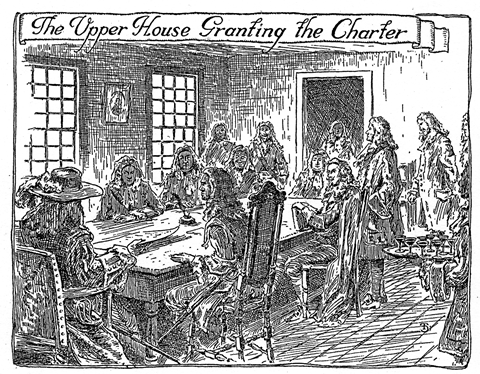 The driving force enlivening Davenport’s plans for a college coalesced when the Pierpont study group began to probe how such a college could be formed. Following the pattern of Harvard, which had received its charter from the General Court of Massachusetts, it was decided to petition the Connecticut General Assembly. To assure the greatest chance for success, they would seek advice from Bay Colony leaders: Judge Sewell and Secretary Addington. As Harvard had done, the “Collegiate School” would be privately founded and authorization to “erect” the college would be sought from the Connecticut General Assembly. To avoid a veto from England, a low profile would be taken, no degree granting authority requested, and monetary requests kept to a minimum.
The driving force enlivening Davenport’s plans for a college coalesced when the Pierpont study group began to probe how such a college could be formed. Following the pattern of Harvard, which had received its charter from the General Court of Massachusetts, it was decided to petition the Connecticut General Assembly. To assure the greatest chance for success, they would seek advice from Bay Colony leaders: Judge Sewell and Secretary Addington. As Harvard had done, the “Collegiate School” would be privately founded and authorization to “erect” the college would be sought from the Connecticut General Assembly. To avoid a veto from England, a low profile would be taken, no degree granting authority requested, and monetary requests kept to a minimum.
The request to the General Assembly would ask for a charter for a school presided over by a single Rector and tutors. There would be no officers or administrators. There would be no resident body of fellows. The Rector would report to trustees who would be a body of ten ministers. As John Davenport had wished, the school would teach arts and sciences for public service to both church and commonwealth.
The ten named trustees in the original charter were:
- James Noyes of Stonington
- Israel Chauncy of Stratford
- Thomas Buckingham of Saybrook
- Abraham Pierson of Killingworth
- Samuel Mather of Windsor
- Samuel Andrew of Milford
- Timothy Woodbridge of Hartford
- James Pierpont of New Haven
- Noadiah Russel of Middletown
- Joseph Webb of Fairfield
The decision by the governor of Connecticut, Fitz-John Winthrop of New London, to hold the General Assembly meeting in New Haven in October 1701 set off a flurry of preparations by James Pierpont and his group to prepare the petition for chartering the Collegiate School. The governor and entourage would arrive in New Haven and preliminary meetings were held with the governor’s advisors and leaders of the General Assembly to include a petition for “Liberty to erect a Collegiate School.” Among key supporters was Gurdon Saltenstall, advisor to the governor in New London, who had attended an August 1701 formal meeting at Samuel Russell’s house in Branford where pledges of support for this initiative were received.
The concept of a college in Connecticut was greeted with enthusiasm by the governor and the General Assembly. Not only was the charter approved, but a grant of 120 pounds per year was added. The original charter contains the ongoing mission of Yale University first endowed on the Collegiate School, that “Youth may be instructed in the Arts & Sciences, who through the blessing of Almighty God, may be fitted for Publick employment both in Church & Civil State.”
The founders quickly accepted the good news of the General Assembly action with a formation meeting that lasted three days in Saybrook (November 1701). In achieving almost unanimous support for the Collegiate School, the politics of location surfaced in a competition between the shoreline pastors and the up-river pastors for being home to the college. While John Davenport had identified the land for a college near the center of New Haven, ongoing political reality forced a compromise in location. By choosing Saybrook at the mouth of the Connecticut River on the Long Island Sound (one of the original settlements of Connecticut), the founders gained support from up-river pastors.
The organization of the college identified a single Rector as head reporting to a group of ten non-resident trustees -- those named in the charter petition. All were Congregational ministers and, the original goal of creating a college competitive with Harvard to educate ministers for the church, was the clear goal. In this, the Age of Reason, the intellectuals of this time clearly understood that their students would seek and need education in the secular philosophies now sweeping Europe. While wishing to serve their God in their time, their foresight to explore other philosophies is forward looking.
The founding principles of the Collegiate School include, authorizing themselves as legal trustees of the school, accepting the gift of books to form a college library from founders and others, adopting a formal resolution founding the college, and selecting a Rector as head. (Israel Chauncy, son of Harvard’s president was offered the position, but declined.) Abraham Pierson was then offered the position with another compromise in location of the school necessary. Pierson, receiving no pay for his leadership, asked to retain his parsonage in Killingworth. This was accepted with the proviso that graduation ceremonies be held in Saybrook. Other decisions were: agreement to employ the Harvard curriculum, that an arts degree would be granted in four years, and a masters degree in another three years.
The birthing of the Collegiate School was accomplished by group effort of remarkable people – leaders and forward thinkers of their time. Though all were ministers, their Puritan ethic and the intellectual climate they knew compelled them to think beyond their pastoral mission as clergymen. Though educated in Latin and theology, they were aware of and participated in the secular advance of western philosophy which brought new ideas of government, deeper examination of human thought processes, discovery of new theories in science, acceptance of Newton’s theories of a mechanistic universe, and establishment of a world of mathematics. Many of the founding families of Connecticut and New England remain here today with pride in their hearts for what their ancestors wrought.

